Daily
Engineers will now register for classes side by side with Arts and Sciences students
Shannon Murphy Local News Editor
Originally published March 13.
On Monday, Tufts announced a pilot program involving new changes to the registration process for undergraduate students. Engineering students will now register two days in advance for School of Engineering and select Arts and Sciences courses required for their degree progress — mostly those under the math, chemistry, biology and physics and astronomy departments — but will register for other classes simultaneously with Arts and Sciences students in their class year at randomly assigned times. Students pursuing a Bachelor of Fine Arts and those enrolled in a combined degree program will register on the same day as their class cohort, but at the earliest registration time available.
This marks a shift from the previous registration process, in which all engineering and School of Museum of Fine Arts combined-degree students registered for all classes one day prior to Arts and Sciences stu-
dents of any class year.
“A significant increase in interest in STEM disciplines at Tufts has occurred at a rate that out-paced the growth of introductory STEM courses at Tufts,” Chris Swan, dean of undergraduate education and an engineering professor, wrote in an email to the Daily. “This has contributed to a bottleneck for students interested in STEM, both in SOE as well as A&S. The new registration process seeks to alleviate the bottleneck, although we recognize that this is only part of the solution.”
An email sent to undergraduate students on Monday said that the registration changes “will address student and faculty concerns with the existing model and increase equity in access to courses across all three undergraduate populations, while preserving priority access for SOE and SMFA students for those courses essential to their degree progress.”
According to Samuel Thomas, professor and dean of academic affairs at the School of Arts and Sciences, the revised process was intended to make registration more
equitable for all Arts and Sciences and Engineering undergraduate students and address the challenges unique to each degree program.
“One of the primary drivers of this pilot has been to reduce the inequities between students in different schools to accessing courses, while recognizing the differences in flexibility that students have in navigating the different curricula,” Thomas wrote in an email to the Daily. “Students in the School of Engineering have a much more rigid curricular plan and students in the School of the Museum of Fine Arts face logistical difficulties due to commuting to the Fenway and studio schedules, which requires special consideration.”
Thomas also mentioned that student feedback has been the driving force behind these changes, exemplified through discussions between the administration and the Tufts Community Union Senate.
“For a number of years, we have heard from students about dissatisfaction with the scale of the reg-
Somerville municipal employees continue fight for fair wages
Grayton Goldsmith Staff Writer
Established in 1963, the Somerville Municipal Employees Association has since grown to represent more than 260 municipal workers, with bargaining units that cover everything from the Department of Public Works to the library department to school nurses. For more than 20 months, however, these vital city workers, prohibited by Massachusetts law from going on strike, have been working without a contract.
Under the previous contract, which expired in June 2022, union workers received incremental wage increases of 1–2%, roughly matching the rate of inflation. The last of such raises took effect in summer of 2021. The Daily spoke to Ed Halloran, president of the SMEA and employee of the Department of Public Works’
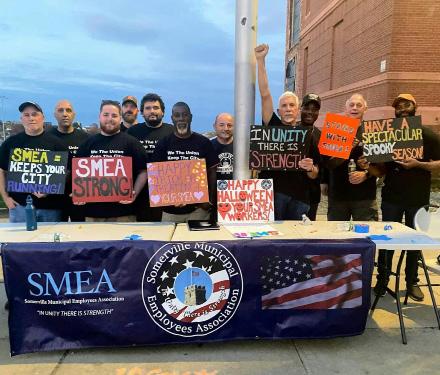
Highway Division, about this contract.
“What happened is that we, as the union, never really recovered [our lost wages] from the financial crisis in 2008,” he said.

Halloran is referring to the worldwide Great Recession of the late 2000s. Similar to the economic hardship brought


istration priority that some groups of students have had over others and these changes are inspired by that feedback,” he said.
Junior Nessren Ourdyl, education committee chair of the TCU Senate, explained the Senate’s role in providing student insight into the process.
“[The administrators] proposed what [the changes] would look like and we kind of gave initial reactions and questions that we had,” Ourdyl said. “I
think that helped smooth out the presentation process of how this would be communicated. We also just asked some clarifying questions that we had as students. They were really just looking for feedback.”
Ourdyl believes that care was put into these changes and has confidence that the changes will have an overall positive impact on students.
Federalist Society panel discusses Trump’s criminal indictments
The Tufts Federalist Society hosted a panel about the criminal indictments against former United States President Donald Trump on March 1 in the Joyce Cummings Center. The panel consisted of Jeffery Cohen, associate professor of the practice at Boston College Law School; Ilya Shapiro, a senior fellow at The Manhattan Institute, a conservative think tank; and the moderator, Tufts’ own Eitan Hersh, an associate professor of political science and civic studies.
The panel opened with compliments to the Federalist Society from Hersh, who stated his goals for the event.
“I hope we can create the vibe of open discourse,” Hersh said.
The beginning of the event served to set expectations.
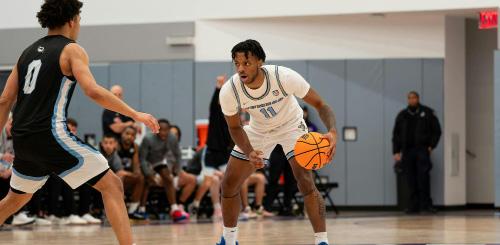




Shapiro clarified that the panel would only discuss criminal indictments against the former president and that the civil suit from E. Jean Carroll against Trump and the New York State civil fraud suit were not relevant to the panel. Shapiro then summarized the four current indictments against Trump.
The first indictment alleges that Trump made false payments to his then-lawyer, Michael Cohen, as hush money about an affair he had with Stephanie Clifford, an adult film actress, also known by her pseudonym Stormy Daniels.
The second indictment alleges that Trump partook in a criminal conspiracy to overturn the 2020 presidential election results in Georgia. In his summary of this case, Shapiro commented on the recent contro-


News Features FuN & Games OpiNiON spOrts Thursday, March 14, 2024 VOLUME LXXXVII, ISSUE 8 Medford/Somerville, Mass. THE INDEPENDENT STUDENT NEWSPAPER OF TUFTS UNIVERSITY EST. 1980 tuftsdaily thetuftsdaily tuftsdaily The Tufts Daily The Tufts Daily tuftsdaily.com 4 FEATURES 9 OPINION 12 SPORTS Coordinators provide Pre-O preview Editorial: Tufts’ gym is running out of room Men’s basketball suffers trinity of losses to Trinity 6 ARTS & POP CULTURE It pays to see ‘Cost of Living’ 1 4 6 8 9 12 arts & pOp Culture
T s
The Tuf
NATALIE BROWNSELL
see REGISTRATION, page
The Science and Engineering Complex is pictured on Oct. 4, 2022.
2
UNIVERSITY
Lang Law Staff Writer
LOCAL
UNIVERSITY
COURTESY KERRY O’DONNELL
Workers in the Somerville Municipal Employees Association are pictured. see WAGES, page 3
see TRUMP, page 3
Deans announce reprioritized registration pilot
REGISTRATION continued from page 1
“I’m hopeful,” she said. “I think it’s going to have its kinks to smooth out, but I’m hopeful and optimistic that this will be a good change for students in their course registration experience. I think it will help smooth out some of the other issues involving overenrollment and mitigate a lot of things within the Tufts academic experience.”
Catherine Freudenreich, professor and biology department chair, explained in an email to the Daily that the previous registration system had resulted in many Arts and Sciences STEM students being unable to secure spots in introductory courses required for timely progress toward their
degrees. Freudenreich believes that the revision to the registration process will assist in reducing this issue for biology majors and Arts and Sciences students in general.
“This will be very helpful for Biology majors who want to get into high demand Biology courses and Biology courses needed for the major in a timely manner,” she said.
For the Department of Computer Science — which offers its majors in both the Schools of Engineering and Arts and Sciences — the change could alleviate the anxiety that Arts and Sciences computer science students feel over losing class slots to engineers.
“Based on guidance from the CS faculty, the vast majority of CS courses, including CS 11, will not
be part of priority registration,” Thomas wrote.
Vedant Modi, a sophomore studying computer science in the School of Arts and Sciences, explained how these changes could allow non-engineering students to pursue preferred classes.
“I could foresee this benefitting [Arts and Sciences computer science students] because [they could] end up in CS elective classes that are necessarily more fun,” Modi said. “I have some friends who … ended up in elective classes that they don’t really want to take, and they don’t really like any of them. And then it’s sort of an extra stress that really shouldn’t be there because the focus should be on the core classes and not some
elective class that you aren’t interested in.”
According to Thomas, registration times will begin at 10 a.m., with 300 students enrolling every 30 minutes instead of the original 15 minutes. After registration concludes, the administration will collect student feedback regarding the new modifications and use it to continue improving the course enrollment process.
“This is a pilot and we will be soliciting feedback about what aspects of registration have improved and any concerns after registration concludes,” Thomas said. “We will use that information to inform how we approach firstyear registration in the summer, as well as registrations in future semesters.”
Career center staff weigh in on sophomore major declaration deadline UNIVERSITY
By March 1, sophomores in the School of Arts and Sciences were required to declare a primary major. This is a hard deadline for all second-year students, with class registration placed on hold upon failure to declare.
While many have already decided on a major, others approached the deadline undeclared. Tufts allows three semesters of open exploration before asking students to pick a path.
Karen Dankers, associate director of the Tufts Career Center, spoke about what components students take into account during the process of choosing a major.
Ty
visi t tuftsdaily.com/masthead
Founded in 1980,
The Tufts Daily is the entirely student-run newspaper of record at Tufts University in Medford, Mass. An editorially and financially independent organization, the Daily’s staff of more than 100 covers news, features, arts and sports on Tufts’ four campuses and in its host communities.
Land Acknowledgement
The Tufts Daily office is located on the colonized land of the Massachusett people and within the territories of the Nipmuc and Wôpanâak (Wampanoag) tribes.
Story tips? Questions? Concerns?
Let us know!
“Some factors are their interests, of course, like what classes they’ve taken so far,” Dankers said. “Which ones have been interesting? We talk about why. Which ones have they not liked? We talk about why.”
In addition to their interests, Dankers said that students also factor in their skills, their personal values, the opinions of their family and their career aspirations. Dankers noted that citizenship can also be a factor. International students pursuing degrees in STEM fields are generally more likely to find Curricular Practical Training authorization than those majoring in the humanities.
“There are students that I’ve met with, where it does seem like a privilege to be able to major in just anything they’re interested in,” Dankers said. “I have had individual conversations with students who maybe are from a lower socioeconomic status who feel pressure, individually and maybe from family, to major in something that seems more quote-unquote ‘employable’.”
Dankers clarified that employability is not dependent on picking a specific major. Many employers are open to a wide range of majors, and also take extracurriculars and work experience into account. At the career center, Dankers ensures that students understand career trajectories from the skills they develop in their chosen field of study.

“Say [a student] wants to major in history, because it’s a huge personal interest, but they think they might want to pursue a business career path in something like consulting,” Dankers said. “We’ll talk about options in terms of experiences, internships, clubs, leadership opportunities — different things they can do and apply for to kind of build of their resume and experience in addition to that major.”
Tufts’ long exploration period before the declaration deadline encourages students to explore new passions. Senior Academic Advisor Ericka Miranda explained that the March 1 deadline allows for students to gain experience in a variety of fields before choosing a single area of study to focus on.
“Many of the academic disciplines that comprise A&S are subject areas that most students may not have any familiarity with from their high school studies, and we want to encourage students to familiarize themselves with a wide range of disciplines before deciding on a primary major,” Miranda wrote in an email to the Daily.
Miranda noted that sophomore year is a good deadline for major declaration because sophomores may want to start planning for internships, research
GRAPHIC BY BEX POVILL
opportunities, study abroad and their path to graduation.
“By [their] fourth semester of study, most students have taken introductory coursework in several disciplines and have a much better sense of what they want to pursue,” Miranda wrote. “In order to ensure that students receive appropriate advising as they begin to progress into some of the upper-level major requirements, we want them to have guidance from a faculty advisor who is more familiar with the nuances of the curriculum and can give tailored advice on how to sequence those courses.”
These factors may encourage some students to declare well before March 1. The earlier a student declares, the earlier they can start planning the opportunities around a specific major.
“Most A&S students declare during their sophomore year, especially during the fall semester and early in the spring semester,” Miranda wrote. “However, we do see some students who are ready to declare by the end of their first year here at Tufts.”
Sophomore Lev Barnett declared his computer science major in the week leading up to the March 1 deadline. Barnett said he considered biology, psy-
chology and cognitive and brain science before deciding on computer science.
“I’m just a lot more excited to do [CS projects] than I am to write a discussion post for psychology or study for a test,” Barnett said. “It’s like, I’ll have a bunch of work to do for different classes, but then CS is the one where I just keep doing it until I get it done. And I don’t want to do anything else until I finish that.”
Barnett said that most other sophomores he knows decided on a major well before March 1. However, he did not feel particularly stressed about the major declaration deadline.
“I tried to focus on the present and just trust that things would work out,” Barnett said. “I feel like a lot of my family members that I know have gone through college [with one major] and then what they do now is just completely different [than their major].”
If he was not required to declare a major by the deadline, Barnett said he may have waited even longer to declare.
“I probably would have rolled along, honestly, if I didn’t have to make the decision right now. And I don’t know where I’d end up with it, to be honest,” Bartnett said.
NEWS 2 T HURSDAY, M ARCH 14, 2024 THE TUFTS DAILY Visit tuftsdaily.com/tips P.O. Box 53018, Medford, MA 02155 T he T uf T s D aily Rachel Liu Editor in Chief Julieta Grané Merry Jiao Managing Editors Marlee Stout Arielle Weinstein Associate Editors Olivia White Production Director Isabel Francis Business Director Matthew Sage Carmen Smoak Nate Hall Toby Winick Spencer Rosenbaum Adi Raman Estelle Anderson Maxwell Shoustal Nina Zimmerman Chloe Nacson-Schechter Veronika Coyle Michelle Shiu Bex Povill Rachel Wong Sarah Feinberg Josue Perez Carl Svahn Megan Amero Sam Berman Siya Bhanshali Mike Kourkoulakos Charlene Tsai Devna Aggarwal Claire Wood Natalie Bricker Kathryn Hood Max Antonini Meghna Singha Tom Jamieson Amber Abdul Anne Li Melinda Yung
Blitstein Caroline Vandis Executive News Editor Executive Features Editor Executive Arts Editor Executive Opinion Editor Executive Sports Editor Executive Science Editor Executive Investigative Editor Executive Editorial Editor Executive Audio Producer Executive Video Editor Executive Photo Editors Executive Graphics Editors Intentionality & Inclusivity Chairs Education Chair Social Chairs Assistant Production Directors Executive Layout Editors Executive Copy Editors Executive Social Media Managers Executive Newsletter Editor Assistant Business Director Ad Managers Alumni Liaisons Editorial Multimedia Committees Production Business
Rose Hollander Staff Writer
Somerville school workers, librarians lack union contract
about by the COVID-19 pandemic, the Great Recession brought with it heightened inflation and a cost-of-living crisis. From the onset of the recession in 2008 until 2011, SMEA wages remained completely stagnant. Halloran argues that, compounded with today’s cost-of-living crisis, the effects of the 2008 recession warrant more than a mere wage increase.
“We need a substantial salary adjustment to put us in line with [neighboring municipalities], and we need raises to keep up with inflation. … Even under our previous contract, the incremental increases … were not keeping up,” he said.
According to Halloran, Somerville’s comparatively low wages have had a tangible impact on the city’s workforce. At the height of things, he says the city was consistently shedding one to two workers per week. In one week last fall, the union lost seven members to other municipalities.
“It’s hard to raise a family, especially,” he said. ”[One employee] recently had a child
and he just said ‘I’ve got to go.’ So now he’s working [in the private sector] and making $34 an hour. You know, many of us just don’t have a choice.”
This mass exodus of personnel has not gone unnoticed by the city. Various city councilors have recognized the difficulties the city has faced in filling poorly compensated union jobs. As a result, some of the work formerly performed by union members has been contracted out to private companies, a practice the city recognizes is not financially sustainable.
“Contracting out work is not considered a long-term or preferred solution by the City, and every effort is underway to hire permanent employees in vacant City positions, including SMEA positions. Part of that effort includes advancing contract negotiations with the SMEA,” a city spokesperson wrote in an email to the Daily.
Although it is not out of the ordinary for contract negotiations to drag on, this bargaining process has been unusually long. According to Halloran, much of the delay can be attributed to the city’s decision to conduct a wage study.
During an interview, Halloran repeatedly expressed his initial surprise at the city’s decision to commission a wage study.
A city spokesperson said Somerville and the SMEA “mutually agreed to pause negotiations to allow the City to complete its City-wide wage and compensation study.”
“The study’s goal is to gather data that will allow us [to] address not just fair wages when compared to other communities/employers, but to identify internal inequities that may exist – including gender inequities, in how the City pays workers performing the same or similar work across departments and unions,” the city spokesperson wrote.
Though the full study is yet to be completed, the portions impacting the SMEA were completed late last year, and both parties returned to the bargaining table in December of 2023. In an interview on Feb. 23, Halloran told the Daily that the city has yet to share its complete findings with the union. In the interim, the SMEA has conducted its own study of wages in surrounding municipalities.
“We’ve now conducted our own wage study, and we’ve told the city that we are behind. We’ve held off on presenting our numbers to the city until they give us theirs,” Halloran said.
When asked why Somerville’s sustained record growth in yearly revenue has not yet translated to a substantial increase in wages for the city’s municipal workers, the city provided the following response.
“The City of Somerville is committed to paying all of its employees fairly for their work, which is why Mayor Ballantyne prioritized completing a rigorous compensation study,” the spokesperson wrote. “The City shares SMEA’s interest in concluding negotiations and entering into a new contract so that these vital employees will have updated compensation and benefits that reflect their value to the City and recent increases to the cost of living. It is important to note that compensation may be updated retroactively if an agreement is reached after the expiration of the previous contract.”
According to Halloran, the union has at last recently
Trump faces multiple cases on election, campaign fraud
WAGES continued from page 1 TRUMP continued from page 1
-versy related to the prosecutor in the case.
“I don’t see that kind of sideshow as much relevant to the merits of the prosecution,” Shapiro said.
The other two indictments, both coming from the federal level, allege that Trump engaged in a conspiracy to defraud the U.S. and falsify the 2020 vote. These indictments also allege that Trump illegally and intentionally withheld classified documents after the end of his presidency.
Out of the four indictments, Cohen believed the weakest case was the indictment relating to the false payments.
“The problem is, I think that when you look into prior cases of the use of this statute, it’s very rare for the prosecutors to use a federal statute as the other crime that they were going to commit.”
He also noted that all of these documents were internal to the Trump organization, and therefore it’s a less clear case.
“[The internal documents] are not things that other people would generally review. Sometimes there are false documents of a business organization that they know the state, for example, is going to look at. And so if they falsify them, then it’s a much clearer case,” Cohen said.
Ultimately, his conclusion was that the indictment is partisan.
“If this were a Democrat, and your sympathies [were] with the Democrats, would you think this was a good prosecution? ... I think it’s hard to say that,” he said.
Shapiro agreed and added that this charge made the pros-
received a wage proposal from the city.
“I want to make it clear that we’re not accepting [the wage proposal] and we’re not rejecting it,” he said. “I don’t want the city to read this and think we’re embracing their offer. We’ve just received it [in late February], and now it’s going to take some time to look over and determine, with all the individual positions, whether or not this will be feasible.”
Somerville’s director of human resources, the department responsible for labor relations and bargaining, did not respond to the Daily’s request for comment.
Overall, the city maintains that its decision to conduct a wage study was in the best interest of all involved, with concerns about gender or other inequities in benefits and compensation. Halloran remains unconvinced.
“I am a traditionalist,” he said. “You know, both sides go into a room and sit down and if it takes a week to reach an agreement then you come back every day and bargain until you have a deal. That’s not what’s happening here.”

ecutor’s other indictments seem less legitimate by association. “This was the first of all the indictments we’ve referenced that was announced by the Manhattan [Defense Attorney] Alvin Bragg and because it’s so out there and looks facially partisan, it tainted all the rest of the indictments,” he said.
Cohen and Shapiro agreed that the other indictments are much more credible, particularly the federal documents charge, noting how brazen Trump’s behavior was in relation to it.
“There was that period of negotiation and then grand jury subpoena. If at any time then, before the raid, Trump had willingly just given back the documents or negotiated whatever
the deal would have satisfied … there wouldn’t have been this indictment,” Shapiro said.
Cohen agreed and added his thoughts on the indictment.
“I’m sure the FBI did not want to do this case. The FBI didn’t want to go into Mar-aLago,” he said.
The panelists agreed still on matters related to indictments alleging Trump attempted to overturn the 2020 election. Cohen noted of the federal election indictment that the prosecution seemed to be intentionally avoiding First Amendment issues in their indictment.
He mentioned that “there’s been some suggestion in the press that the First Amendment has something to do with this
case. … But in reality, the indictment and I think Jack Smith [special counsel prosecuting the case] was very careful not to make this indictment about first amendment conduct. In fact, he says in the indictment that everybody has the right to contest the election.”
Cohen also supported the ruling against Trump’s claim of presidential immunity in a D.C. circuit court and shared his hope that the Supreme Court, which recently took the case, will uphold the circuit court’s ruling. However, they noted that due to the court not expediting their decision, the criminal trial will likely conclude after the election.
The two panelists were also in agreement about the moral
issues, expressing a belief that Trump should be prosecuted for these alleged crimes.
“I hope that the decisions that come down from the Supreme Court … will be a presidency that is not above the law, but still allows the president discretion to do what they need to do as official acts,” Cohen said.
Shapiro added that “the conventional wisdom is that there’ll be unanimous or near unanimous court, to reverse the Colorado Supreme Court in the 14th Amendment case,” something he believed would aid public trust in the court.
SCOTUS did ultimately overturn the Colorado Supreme Court just a few days after the panel.
NEWS 3 T HURSDAY, M ARCH 14, 2024 THE TUFTS DAILY
LAUREN ALIOTTA / THE TUFTS DAILY
The Joyce Cummings Center is pictured.
FEATURES
Meet the students behind pre-orientation programming at Tufts
The transition from high school to college can be a daunting experience, especially for those traveling far from home to spend the next four years in Medford/ Somerville.
Tufts aims to support incoming Jumbos with their adjustment through an optional opportunity: pre-orientation programs. Pre-Os, as they are known around campus, allow students to get a jump start on building a community, pair up with upperclassmen mentors and leaders and meet other students whose interests or identities may align with their own.
With over half of the incoming first-year class participating in a Pre-O, a large variety of driven Tufts students is necessary to coordinate and lead these programs.
Carly Rothschild, a sophomore peer leader for the Students Heightening Actionable Political Engagement program, was drawn to the peer leader position due to her positive experience with Pre-O as a first-year.
“Experiencing [Pre-O] firsthand, and seeing how Tufts is dedicated to welcoming our first-years made me want to be a part of that whole orientation programming community,” Rothschild said. “I think it’s really special what Tufts does, in the sense that they pro-
vide so many opportunities for first-years to apply to what they’re interested in and meet other students that are like-minded.”
SHAPE, a new Pre-O that launched for the first time in fall 2023, connects students with resources for civic engagement and community involvement. However, Rothschild found the relationships and community built through SHAPE were just as impactful.
“I didn’t know any of the peer leaders, and now some of them are really close friends,” Rothschild said. “When you’re in that environment with like-minded people who want to be on campus to welcome first-years and show Tufts’ values. … It’s a really special experience and I wasn’t expecting to get as much out of it [as] I did.”
Rothschild is returning to SHAPE in the fall of 2024 as a student coordinator, and wishes to expand the program to a larger variety of interests within the intersection of civic engagement and politics.
“We’re looking to scale up in terms of the amount of participants, and, with that, I think it’d be really cool to have multiple concentrations,” Rothschild said. “This past year we focused a lot on health equity and access to technology. … I think it could also be cool to have those same hands-on experiences and let students choose whether
they want to concentrate on maybe housing, health equity, climate change and other issues.”
Similar to Rothschild, Abigail Pineda, a sophomore student coordinator for Building Engagement and Access for Students at Tufts for 2024, had a good Pre-O experience thanks to her peer leader and wanted to give back to the community that supported her during the start of college, had a good Pre-O experience thanks to her peer leader and wanted to give back to the community that supported her during the start of college.
“When I did do BEAST, I felt my [peer leader] made the experience very comfortable and I felt seen and heard and [like] my feelings were validated,” Pineda said. “Being grateful to have a [peer leader] that made me feel comfortable in this space made me want to give back and be there for other people and other incoming [first-years].”
However, being responsible for an entire cohort of first-year students during such a pivotal moment in their college experience is not an easy task. Communication, emotional intelligence, time management and listening skills are all necessary skills that peer leaders must learn to utilize during their time volunteering for Pre-O programs.
“You are the person they’re learning from. … You’re in charge of
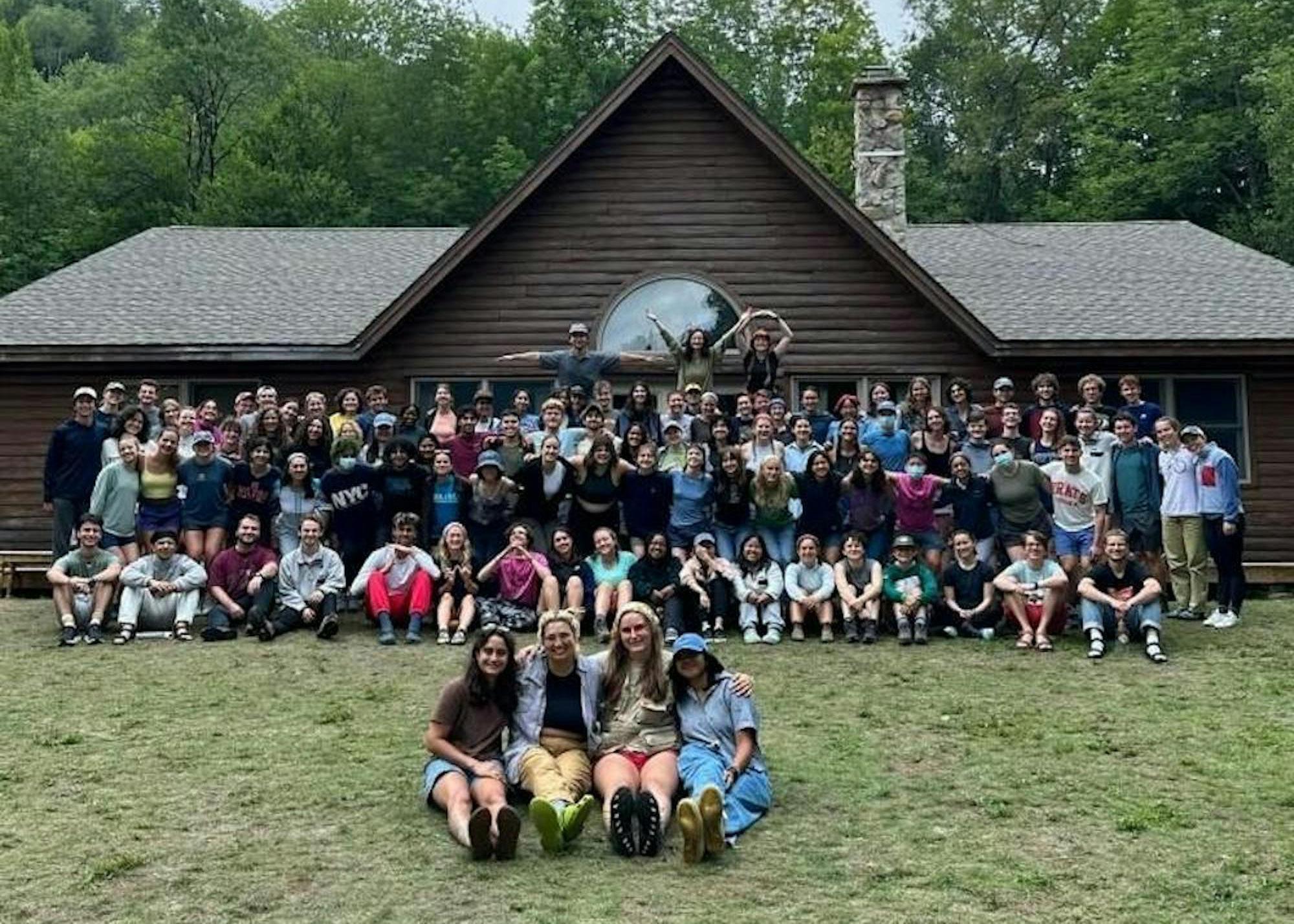
the whole group. … You have to pay attention to your mentees and make sure they’re good.” Pineda said.
BEAST is geared toward first-generation, undocumented and low-income students, and the resources and opportunities it provides remain valuable for both its participants and leaders throughout their time at Tufts.
“Even if we didn’t [all] share similar identities, just having that core ‘Oh you too?’… you slowly start to realize everybody goes through similar things. You feel comfortable. You feel connected,” Pineda said. “I specifically chose BEAST because I wanted to feel that connected. I wanted to feel that sense of being seen and feeling like I belong. Being first-gen was kind of scary, and so I just wanted to ensure that I was … in [a] community with people who understood that.”
Senior Claire Bolash is a Tufts Wilderness Orientation student coordinator for fall of 2024. She was both a participant and leader for TWO, and, after working on ways to improve the program before her senior year, became interested in the coordinator position.
“Over the summer, I worked with one of the [coordinators] to restructure the mental health training, and I [realized] I like thinking about TWO and how to plan all of these things on this bigger institutional level,” Bolash said. “After TWO ended this year, I found myself thinking a lot about the program and feeling like there was so much more I wanted to engage with the program and also the community [about].”
To lead a TWO trip, leaders undergo training and learn to build confidence in their judgment to make tough decisions for their groups.
“I think the challenge that every leader faces, whether or not it’s their first trip or their second, is … knowing that you can trust yourself and you’ll make the right decision,” Bolash said. “Learning to trust myself and learning to feel confident in my decision-making and my training was definitely a big learning curve.”
But Pre-O leaders can also gain more from their role than training and mentorship opportunities. Bolash was initially surprised by
the strong community that binds the TWO staff together.
“I wasn’t aware of what being on staff would be like in terms of how it’s a community that continues to show up for each other all of the time. … Everyone is very caring and very approachable,” Bolash said. “That’s something I didn’t expect to gain from being a leader. … Having joined such an amazing community that shows so much care and mutual support to each other was a huge advantage and something that makes me keep coming back to this space time and time again.”
As a student coordinator, Bolash aims to emphasize TWO’s values of making the outdoors accessible to all, regardless of previous experience.
“What I’ve always loved about TWO is it was such an awesome avenue for me to enter into outdoor recreation and outdoor spaces,” Bolash said. “You don’t need to have any outdoor experience to join staff. And so what I’m hoping to do during my time as [a student coordinator is] to continue that ethos and [make] our space feel more comfortable and approachable.”
An enduring feature of many of these Pre-O programs is the community that persists after the program itself, and that the first years continually utilize the connections and relationships acquired during Pre-O.
“Seeing that [former participants are] actively looking for you outside of the pre-orientation has made me realize that people do see me as a leader. I have responsibilities to give back; I want to give back,” Pineda said.
The Pre-O experience is an enriching experience for all of those involved, and being able to actively contribute to the Tufts community in such a meaningful way is what continues to capture the interest of first-years and upperclassmen alike.
“I think my experience [during] pre-orientation both as a participant and a peer leader, again, made me realize how important this one week is for incoming [first-years],” Rothschild said. “I really like the core values that Tufts instills in students through this pre-orientation, with the diversity of interests and people to learn from and people to meet.”

FEATURES 4 T HURSDAY, M ARCH 14, 2024 THE TUFTS DAILY
Trey Lawrence Features Editor
COURTESY TUFTS WILDERNESS ORIENTATION
The staff of TWO is pictured outside the Loj in Woodstock, N.H., in August 2023.
Challah for Hunger: Addressing food insecurity one loaf at a time
Claire Wood Assistant Features Editor
Originally published March 12.
Every other Thursday, the kitchen of the Tufts Hillel building is bustling with dough-makers, braiders and bakers alike, all helping to bake about 70 loaves of challah to be sold for charity through Challah for Hunger, a philanthropic program organized by Hillel.
Challah for Hunger aims to ameliorate food insecurity in the Greater Boston area and beyond. Co-chairs Elijah Fraiman and Corey Title spoke to the Daily about the production process behind making challah, a Jewish sweet bread that is often eaten to celebrate Shabbat.
A number of challah varieties are sold in each batch, with the program adding new flavors through the years. Right now, they sell chocolate chip, sweet crumb, everything bagel, cinnamon sugar and plain.
“Sometimes we’ll change it up a little bit, add a new flavor. … We added sweet crumb at the beginning of this semester,” Fraiman said. “Since the Tufts Hillel kitchen is kosher, all of the challahs are kosher, but also dairy free.”
The production process is intensive and requires nearly an entire afternoon to complete.
“For most people, [the baking process] begins at 3 p.m.,” Title said. “We make the dough from 3 p.m. to 4 p.m., let it rise from 4 p.m. to 5 p.m., 5 p.m. to 6 p.m., we’ll braid it, and we’ll let the braided challahs rise from 6 p.m. to 7 p.m. [From] 7 p.m. until [the] end of [the] night, we’ll egg wash them, put toppings on them, cook them and then sell them fresh out of the oven if people want to come early and buy them.”
The following morning, the team will sell challah out of the Campus Center for just $5 a loaf. They open at 10 a.m. and sell until 1 p.m. — or until they’ve sold out. Their loaves are purchased by a myriad of customers, including both regulars and newcomers.
“Students, community members, prospective parents, prospective students, just sort of anyone who might be in the [Mayer Campus Center]and interested in buying a challah can and sometimes do buy, which is really cool,” Fraiman said.
While the program previously had a presence at Tufts Hillel before the COVID19 pandemic, the program was revamped by Title during the spring 2023 semester. Since then, Challah for Hunger has significantly grown in scale, enabling Hillel to donate even more money to those in need. Title elaborated on the success of the program in the spring 2023 semester:
“We made about 100 loaves of challah and donated about 300 to 400 dollars,” Title said.
In terms of how successful the program has been as of late, Fraiman expressed his pride regarding what they have managed to accomplish.
“We’ve baked 487 loaves of challah,” Fraiman said. “We’re very proud to say that we’ve donated $2,200 so far this year.”
As the name suggests, Challah for Hunger focuses on reducing hunger, particularly in and around Boston.
“The name of the game is food insecurity,” Fraiman said. “The [charity] we’re donating to mostly is called Family Table, which is a kosher food pantry for people in the Boston area.”
The chairs of the program determine which charities demonstrate the most need and make donations accordingly.

All proceeds go towards food pantries and other hunger-reduction organizations.
The charitable efforts of the program are undeniably productive, but the positive impacts of the club do not end with philanthropy. The club also promotes a strong sense of community, garnering numerous volunteers, many of whom come in regularly for the challah baking process.
“It’s really nice that you get to make friends and have community while doing something good and making a difference,” Title said. “And, at the end, you also get a good product.”
Currently, the club consists of approximately 40 volunteers. Because of the nature of a step-by-step baking process, volunteers will usually come for different shifts. However, rather than leaving after completing their tasks, many participants stay in the Hillel building throughout the evening to chat with their peers, highlighting the tight-knit nature of the community.
“At the end of the night … [you] see 20 people just hanging out at the bottom floor of the Hillel building, just talking and having fun, and it’s really cute,” Title said.
Lizzy Osinski, Mandy Vendittis and Mia Spiegel, social media managers for the program, spoke about the strong community forged among regular attendees, with each emphasizing their love for the process.
“It’s very therapeutic, and I love spending time with friends as I braid challah,” Spiegel said.
Vendittis expressed a similar sentiment, adding that the charitable aspect of the organization makes the experience all the more worthwhile.
Max Druckman Munching With Max
Typically, I structure my munching around a specific theme or location. However, for this edition, I’m relaying a valuable life lesson — your plan may not always pan out the way you expect, kids. In the iconic words of Forrest Gump, “Life is like a box of chocolates, you never know what you’re going to get.” And so, due to my meal planning failures, I present a menagerie of munching.
First up, OGinger, a Japanese restaurant in Davis Square. Despite the modest setting, the menu was filled with intriguing maki options. I chose the Elyse Special. Featuring spicy cooked scallops and king crab meat topped with yellowtail and “special sauce,” the combo worked delightfully. The yellowtail was fresh and its smooth texture meshed well with the rice and sesame seeds that encircled the roll. The scallops and crab were fresh and flavorful. The real standout was the “special sauce.” Tangy, sweet and spicy, it wrapped the dish up neatly in a bow. Overall, an enjoyable roll and restaurant within walking distance of Tufts’ campus.
Next, Yankee Lobster Company in Boston’s Seaport District. Featured in the Food Network series “Diners, Drive-Ins, and Dives,” my expectations were sky high. It is a little (meaning a lot) out of the way and took well over an hour to get to via the MBTA. I chose the Skipper’s Platter, which was piled high with fried cod, shrimp and calamari. The plethora of grease necessitated more than the minuscule cup of tartar sauce provided. Still, the freshness managed to shine through the
“I love braiding [challah],” Vendittis said. “It’s good knowing that you’re doing something that actually is giving back.”
The outreach work through platforms such as Instagram has proven to be especially rewarding for Osinski, as it helps grow the program.
“My favorite thing about Challah for Hunger is running the social media account,” Osinski said. “It’s really fun to advertise and get more people involved.”
Many members of the program hope to recruit new bakers and sellers, which would help increase the amount of challah produced.
“I think that more people should join. It’s a great community, and if the club expands, we can make even more challahs and more proceeds can be given back to the community to reduce hunger,” Spiegel said.
Challah for Hunger is an inclusive organization that accepts any and all volunteers willing to bake. Notably, you do not have to be Jewish in order to participate in the program, something Fraiman emphasized.
“Challah for Hunger operates under Hillel, but no experience in baking challah is required. You don’t have to be Jewish. You don’t have to have ever eaten challah or even seen it to come,” Fraiman said. “We’d love to have anyone who’s interested.”
At the end of the day, the community service aspect of Challah for Hunger proves integral to the program’s appeal.
“We’re really happy with the success we’ve had so far,” Fraiman said. “We’re really proud of the impact we’ve had both on building community, but also the fact that this money is … not just going to someone’s pocket, it’s going to charity to help feed people in need.”
heavy breading. The cod was succulent but the shrimp and calamari were sometimes indistinguishable, making it difficult to savor unique flavors. The side of fries was crispy and perfectly cooked. For a fried fish platter, it was a solid rendition of a classic dish.
And finally, pizza. Following my club baseball game, the team reconvened to celebrate Saturday’s victory with a pizza party. Having played the full nine innings with no lunch break (hangry much?), the meal, from Angelina’s Pizza in Teele Square, was highly anticipated. However, after my first bite, I was extremely disappointed. The slice was hot, but the sauce was bland and the cheese was reminiscent of glue. There was a complete lack of flavor. The pizza — including the crust — was so soft that I began to doubt whether it had been cooked enough. Each bite felt laborious, instead of scrumptious. What seemed like a perfect match, baseball and pizza, was a strikeout.
As always, my gut reactions:
OGinger Elyse Special: Nice roll, nice restaurant. Check it out in Davis.
Yankee Lobster Skipper’s Platter: Its fresh, no-fuss fare makes it a must-visit for those seeking authentic New England seafood. But, maybe stick with the lobster roll.
Angelina’s Pizza: I prefer not to speak on this. If I tried, I’d be in big trouble.
While some of us may have been bothered by the lack of culinary cohesion, variety should not be shied away from. It is, after all, the spice of life. So, if my column has left you with any takeaways, I hope it’s that variety is your friend (and that we need more good pizza places)!
FEATURES 5 T HURSDAY, M ARCH 14, 2024 THE TUFTS DAILY
Commencement 2024 Visit our website at commencement.tufts.edu University Commencement Office 617-627-3636 commencement@tufts.edu Save the Date SUNDAY, MAY 19, 2024 Don’t forget to stop by the Commencement Fair at the Campus Center on April 3 to pick up graduation announcements and other commencement-related information. Senior Days at the bookstore will take place on April 3 and 4 for robing orders. Menagerie of munching
Max Druckman is a first-year who has yet to declare a major. He can be reached at max.druckman@tufts.edu.
Paul Osmond
For the Culture
Hip-hop has no more superstars
So, maybe hip-hop is dying?
Currently, out of the four major streaming platforms, Spotify, Apple Music, Amazon Music and YouTube Music, Apple Music is the only platform with hip-hop/rap as the top genre.
On the remaining three platforms, coinciding with the leading global music genres, pop music is the No. 1 genre. Although hip-hop remains one of the most popular music genres in the United States in 2024, in the third quarter of 2023, country and pop were tied for the most top 10 singles on the Billboard Hot 100 chart. Steadily, hip-hop has diminished in influence and popularity as pop, Latin and Afrobeats music have arisen to supplant the genre and country continues to be well received.
Now, as I have explained in previous articles, the decline of hip-hop is incredibly complex. However, one element that hip-hop lacks is generational stars. In the 2000s, Jay-Z, Eminem, 50 Cent, among others, were recognizably dominant artists, not just in hip-hop but mainstream music in general. They were superstars. In the 2010s, Drake, Kendrick Lamar and J. Cole supplanted their predecessors as “The Big 3” of hip-hop, leading record sales, fan popularity and influence over the genre. However, since the start of the 2020s, many fans, pundits and hip-hop media outlets have regarded “The Big 3,” having each passed their 35th birthdays, as having passed their primes.
So, who will arrive to carry the torch? Well, there are no clear candidates. Formerly considered the understudy to Drake and J. Cole alike, Lil Baby had immense potential to capitalize on his sheer talent and work ethic. However, his recent projects, singles and social media posts have demonstrated a decline in the technical and thematic prowess that garnered him fame. Similarly, Roddy Ricch, who emerged in mainstream hip-hop in 2019 and was championed for his dynamic melodic rapping and clever lyricism, disappointed fans with back-toback substandard releases. Unfortunately, both artists, along with other up-and-coming rappers, have failed to cement themselves as hip-hop superstars.
Previously, hip-hop fans had recognizable figures whom fans could reliably revere as the ‘best.’ Just as pillars are necessary to uphold buildings, superstars are necessary to uphold genres. Whereas 50 Cent, Jay-Z and Kanye West were previously genre-defining artists — their projects, literally, defined the hip-hop genre — I believe there are no artists today whose music can define the genre. Today, there are no more hip-hop superstars.
Here, I believe, is where country music begins to triumph — there are rising superstars. Chris Stapleton, Luke Combs and Morgan Wallen, for instance, have developed into recognizable stars within the genre. Although the genre has not yet consistently surpassed hip-hop/rap in terms of top streaming genre and Billboard-charting tracks, country music fans can firmly identify with superstar artists whose artwork continues to represent, define and popularize the genre.
Paul Osmond is a fourth-year combined-degree student studying English. Paul can be reached at paul.osmond@ tufts.edu.
& POP CUlTURE
ARTS & P OP CUlTURE
SpeakEasy Stage’s ‘Cost of Living’ embraces vulnerability and disability
Elizabeth Foster Senior Staff Writer
Running March 8–30, SpeakEasy Stage Company brings Martyna Majok’s “Cost of Living” to Boston audiences. Winner of the 2018 Pulitzer Prize for Drama, Martyna Majok’s play speaks to the fragility of life by interweaving the lives of four individuals, each one hardship — emotional, financial or physical — away from ruin.
Running 1 hour and 40 minutes with no intermission, “Cost of Living” is a beautifully paced show. Moments of tenderness and intimacy punctuate the daily, private experiences of people with disabilities and those who care for them. Between these moments, Majok develops her characters. As she explains in the script notes, “selfpity has little currency. … Humor, however, has much.”
Lewis D. Wheeler’s opening monologue introduces Eddie, an unemployed truck driver who is eloquent and authentic as he laments the loss of his estranged wife, Ani (Stephanie Gould). The timeline of the show then skips back a few months to tell the story of the couple’s relationship following an accident that results in Ani’s paralysis. Gould’s Ani is both raw and real, with a biting wit that reveals the depth of the character’s hurt as she processes the changes in her abilities and relationship with Eddie. From the top of the show, Wheeler delivers an honest performance as he expresses Eddie’s grief, guilt and growth.
Meanwhile, John (Sean Leviashvili), a Princeton University Ph.D. student with cerebral palsy, is living on his own and seeking a private caretaker. Jess (Gina Fonseca) is a first-generation Princeton graduate holding down several jobs, including multiple bartending gigs, who now is John’s caretaker.
This pair’s story is about judgment of physical ability, prestige and attractiveness. Through their relationship, audiences view the intimacy and humanity required to be a
Natalie Bricker
The Bookmark
‘Family of liars’ by E. lockhart
Disclaimer: This article contains spoilers for “We Were Liars” (2014) and “Family of Liars” (2022).
ELockhart’s “We Were Liars” holds a special place in my heart. I’m in awe of the way Lockhart pushes the bounds of typical fiction writing. She mixes in unique line breaks so that her book sometimes reads like a poem. She also creates incredible metaphors, like the witch in the first novel, that are so vivid, they have stuck with me to this day. I haven’t reread the book in over two years and I still think about it all the time.
Needless to say, when I found out this book is one of a series, I immediately picked up the second novel. “Family of Liars” is the prequel to “We Were Liars” and tells the story of the previous generation of the family from the first novel. There are similarities in these novels, including the murder of a boy the protagonist loves, an addiction to pills and parents who are unable to talk about their grief.
Protagonist Carrie Sinclair grapples with the complicated life of her family.
caregiver and how this is at odds with Jess’s initially hesitant and guarded approach to the job.
This narrative weaves class struggle throughout: John’s status as independently wealthy affords him the freedom to live on his own and hire an aide outside of an agency, while Jess is separated from her mother, who left the U.S. to receive more affordable healthcare, and works to send money back to her.
Director Alex Lonati masterfully navigates the ebb and flow of developing trust between lonely souls facing the precarity of life. These two plot lines occur in parallel, each slowly revealing the lives of the characters on their respective halves of the stage. Walking the full length of the stage during a scene of stunning snowfall and isolation, Jess bridges these stories before the final scene plays out center stage.
As these characters’ stories converge, so does the play’s timeline. Eddie’s opening monologue precedes a flashback in time. The play then flows chronologically, leading up to the final scene, which occurs immediately after this monologue. However, the initial leap back in time was unclear and left some primed to question Eddie’s intentions and transparency with his separated wife. Once the timeline resolves in the final scene, questions of when Eddie and his wife separated, when
the accident occurred and when his wife finally left him are answered.
Like herself, Majok’s characters have “lived a lot of life.” Majok’s own story shares experiences with Jess, having balanced bartending jobs with caretaking two disabled men. From this season of labor paired with the grief of losing her grandfather, Majok wrote Eddie’s opening monologue.
Despite the play’s critical acclaim, it has a reputation of being difficult to produce for its stipulation of casting disabled actors in the roles of Ani and John. Actors Gould and Leviashvili both live with cerebral palsy. Gould, whose credits include roles on “Orange is the New Black” and several off-Broadway productions, shared with the Boston Globe that her mentor stressed that her disability “would become ‘an asset’ one day.”
Brennan Srisirikul, consultant and community liaison for SpeakEasy Stage’s production, expounds upon the connection between disability and theater, explaining that because “disabled people and our stories are oozing with possibility and creativity,” theater opens an imaginative and ingenious space for this possibility to flourish.
“Cost of Living” runs through March 30 in Boston’s South End, with student rush tickets available for $15 and general admission tickets starting at $25.

The Sinclair family will do anything to protect themselves and appear perfectly happy, even if that means denying murder: “They’re doing just as I asked them to. As we Sinclairs always do. Pretending. Lying. Trying to have a good time.”
Carrie doesn’t like many parts of her family, but she also recognizes her own enjoyment of their wealth, as she loved growing up on their private island: “I am white cotton and sandy feet, old money and lilacs, yes—and yet my insides are made of seawater, warped wood, and rusty nails.” Metaphors are a specialty of Lockhart’s, and they’re peppered throughout the novel in a unique way, which was something I loved so much about her writing from the first novel. I love her use of phrases like “beautiful moonlight boy.”
This book takes place in the same world as the first, taking readers back to the Sinclair’s beautiful private island. The setting reminds the reader of a classic summer romance vibe that’s found in stories like “The Summer I Turned Pretty.” If you like the summer romance genre, you should definitely read these books. Lines like “I hear the echo of the waves, feel the warm drumbeat of the sun and the cucumber cool of the seawater against my skin” evoke warm, summery feelings — although, be forewarned that it’s not all happy and dreamy like some classic summer romances are…
Both books hint at something ominous to come, but the pieces don’t click until much later in the story. The secret in this book was dark, which I was expecting after reading “We Were Liars,” but I was still surprised by some of the gory details incorporated in the murder scene.
“We Were Liars” is easily a five-star rating from me, but its prequel is closer to 3.5 or 4 stars. It was still a great read, but it didn’t quite meet the perfection of the first one. I think that’s partly because I was so attached to the first novel, in which the mothers are so villainized, that it was hard to enjoy reading from the quasi-villain’s perspective. These books are also so amazing during your first read, because the twists are so jarring, but perhaps I was expecting a surprise in the second one, so it wasn’t as effective. My love of the first novel bumps the prequel’s rating to a 4/5.
I’ll leave you with a final quote, as always:
“Those deaths can never be undone. The loss is a canyon, yawning wide, rippled with stones and striated with layers of clay and silt. I have been thrown into the canyon and will never be able to climb out. I must live out my days in this loss.”
ARTS & POP CULTURE 6 T HURSDAY, M ARCH 14, 2024 THE TUFTS DAILY
Bricker is a senior studying English. Natalie can be reached at natalie.bricker@tufts.edu.
Natalie
COURTESY NILE SCOTT STUDIOS
Gina Fonseca and Sean Leviashvili are pictured.
6 months for $0. Streaming, savings, and free delivery. New members only. Terms apply.
ADVERTISEMENT 7 T HURSDAY, M ARCH 14, 2024 THE TUFTS DAILY

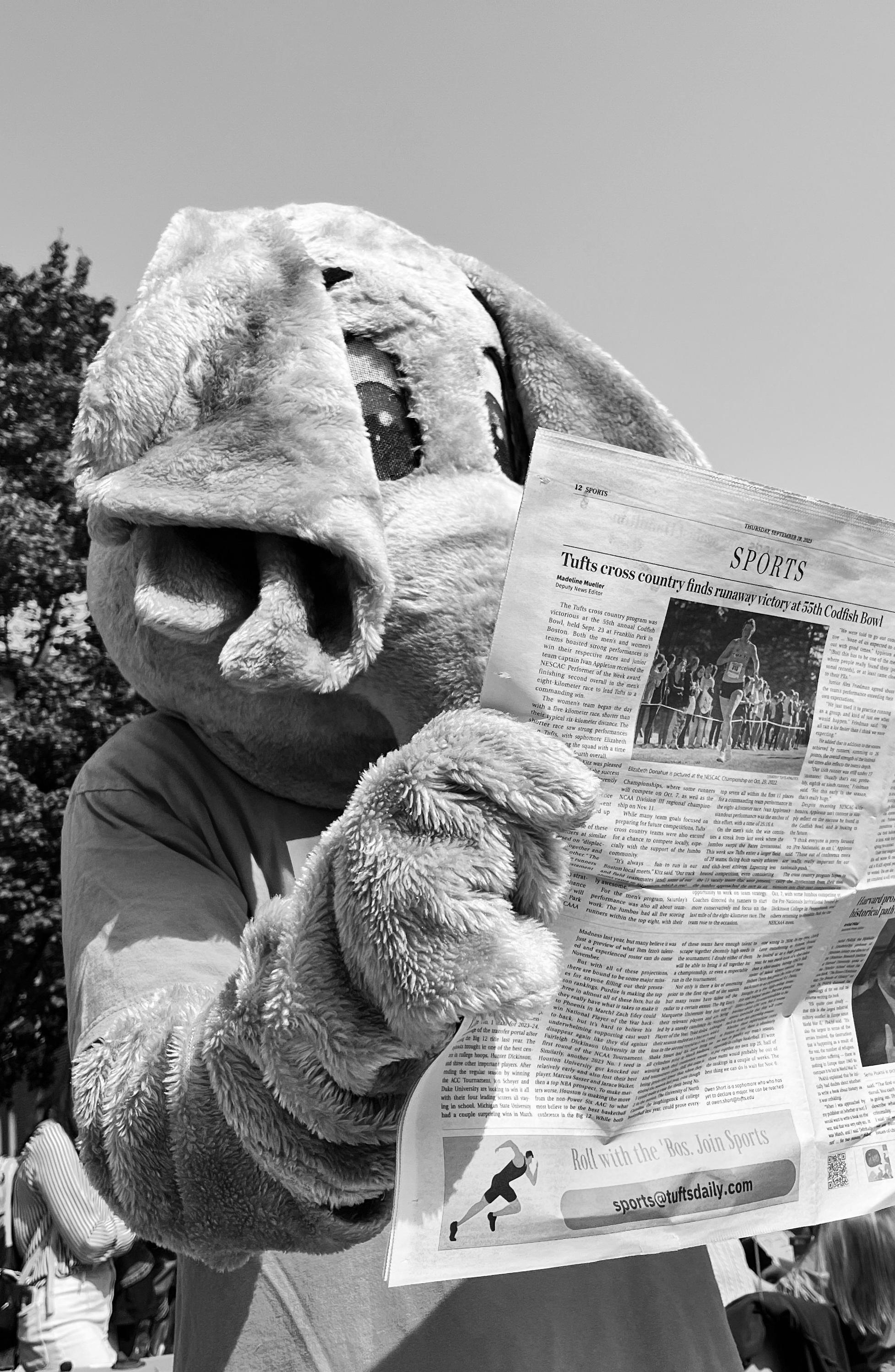
Late Night At The Daily





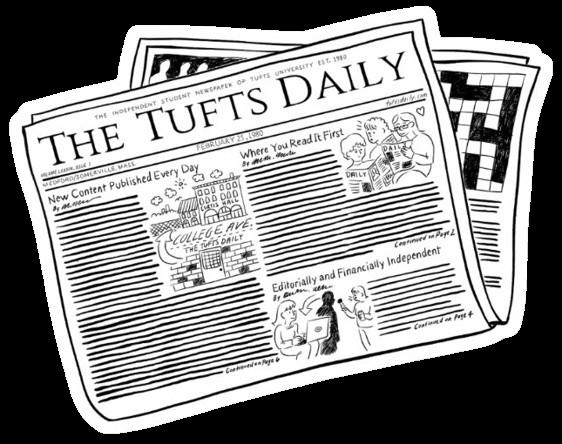

FUN & GAMES F UN & G AMES 8 T HURSDAY, M ARCH 14, 2024 THE TUFTS DAILY F& G
CROSSWORD SUDOKU CROSSWORD Difficulty Level:
pi. SUDOKU Copyright © 2024 SudokuTodo | For personal or classroom use only. Play online or make your own free printable sudoku at SudokuTodo.com Fill in the puzzle so that every row across, every column down and every 9 by 9 box contains the numbers 1 to 9.
Puzzle
9 5 3 8 4 9 4 1 5 3 2 9 8 7 9 7 5 8 6 5 9 4 3 1 1 2 9 6 3 9 8 4 Marlee: “The
Abbreviation Nation Claire Wood 1 2 3 4 5 6 7 8 9 10 11 12 13 14 15 16 17 18 19 20 21 22 23 24 25 26 27 28 29 30 31 32 33 34 35 36 37 38 39 40 41 42 43 44 45 46 47 48 49 50 51 52 53 54 55 56 57 58 59 60 61 62 63 64 65 66 67 68 69 70 71 72 73 74 75 76 77 78 ACROSS 1 Baby goat 4 English boys' college known for their messy pavlova 8 Famed Tufts lawn 12 Olympic sledding sport 13 Nickname for Natalia, perhaps 14 You might use his method in Calculus 16 Little girl in David Copperfield 17 "Talk soon," in texting lingo 18 Three-wheeled vehicle 19 National Audit Office, abbr. 20 Pursue legally 21 "Old MacDonald had a farm, _-_-_-I-O" 23 New England Conservatory, abbr. 24 There ____ such a clatter 26 Attempt 28 Zero, in tennis 30 Coupe Light Sport, abbr. 32 At any time 36 Sacred 39 Pit 41 Epic, or long story 42 Before 43 Disgraced conspiracy theorist Dawson 45 Nongovernmental organization, abbr. 46 Med school entrance exam 48 Crime investigation show 49 Singer Alicia 50 David Ortiz, aka Big ___ 51 ___ choy 52 US spy org 54 Gold, in Barcelona 56 Color opposite of red 60 Long bob, perhaps 63 "No thanks" 65 Zero 67 Center for Law and Education, abbr. 68 44th US President 70 What Swift might call Kelce 72 Roly ___ 73 Singers Lennon and Mayer 74 Zuckerberg's company 75 Famed Egyptian queen's nickname, perhaps 76 Refer___ 77 Columbia's mascot 78 Element Sn DOWN 1 Tufts' president 2 Ice house 3 Defending the Early Years, abbr. 4 "And you?" in Lyon 5 Singer McRae 6 Olympic post-nominal letters 7 River in Egypt 8 The Vatican's basilica is named for him 9 Rossum's Universal Robots, abbr. 10 Romance novelist Hilderbrand 11 Nickname for Ezekiel, perhaps 12 Portrayer of Cersei Lannister 15 Suggestion, abbr. 20 Southeastern University, abbr. 22 "___ alive!" 25 Cunning 27 Sí, oui 29 Analog video recording format 30 "Click, ____, Moo: Cows that Type" 31 Look-alike daughter of Heidi Klum 33 Wind direction device 34 Abounding in eggs 35 NY-based restaurant + sauce-maker 36 Cannabis plant 37 Killer whale 38 Jump 40 Uh oh! 44 Key at the top-left of a keyboard, abbr. 47 Uncle, in Málaga 49 You may donate one for a Kid 51 ___ constrictor 53 Tisch College's global leadership org, abbr. 55 Enzyme that degrades RNA 57 Bacteria once linked to Chipotle's lettuce 58 Comedian DeGeneres 59 He sings "Time of Our Lives" with Pitbull 60 TMC's Cabin 61 A certain double-reed instrument 62 ___ Mì 64 Common webpage code 65 Western Bloc org, abbr. 66 Tsar ___ the Terrible 69 Multinational corporation, abbr. 71 Outdoor equipment store 72 Pacific Crest Trail, abbr. Interested in submitting a puzzle? Reach out to production@tuftsdaily.com LAST PRINT’S SOLUTIONS: Heavy Metal M A I D E N T V E S C E O B T U S E M R P E A N U T T O A S T J O E N A M A T H I D T E R E S A R S F E R E B A T E S E A T C S B I R H O D E P O E T A U C T O N E E R 39 E R N E 40 S T S 41 A V E S T A N 42 A C T O N H 43 E R O 44 E E L S 45 R A 46 N L E 47 N N 48 T S 49 T W 50 C 51 E T 52 A M 53 N 54 E 55 C 56 U H A O I S E A U A C R A R E E A R T H R H I N O A L A C R I T Y A T N O O N J E T S N A C H O S E N ACROSS 1 British rock band Iron ____ 7 Window to another world 9 Glowing suffix 13 Dense 14 "Ah, nuts!" mascot 16 Browned bread 17 69A Legend 18 Something you always keep with you 19 Mother 21 Some people can roll them 22 Iron 23 Sale sweeteners 26 Partake of 28 Popular Tufts major 30 Two-pronged suffix 31 Chi's partner 33 Opposite, prefix 34 Dickinson, say 36 Fast talker 39 Author Hemingway and explorer Shackleton 41 Ancient Iranian language 55 Wire essential (abbrev.) 57 LOL 58 Petit chanteur 60 Half an Aussie rock group 61 Precious metal 65 Serengeti lumberer 67 Cheerful willingness 68 When two hands meet 69 NY's embarrassment 70 Salt metal 71 Anakin and Paul Atreides, say DOWN 1 Recurring theme 2 "Humble" dwelling 3 Spanish diminutive 4 Common allergen 5 Organic compound 6 Home of the Patriots October 31 choice 8 Work from 15 It's in the game 17 Son and brother of George 20 Regarding, abbr. 24 Harriet Tubman portrayer Cynthia 25 It's about a foot 27 Gull relatives 52 Vital vessel 53 NW's cousin 54 Our homeland 55 Camp craft 56 2016 NCAAW Basketball Champs 59 Not happening 61 Awkward Big Bang Theory ‘Abbreviation Nation’ by Claire Wood WHERE YOU READ IT FIRST. SUBSCRIBE TO OUR NEWSLETTERS: The Daily now has merch! VISIT TUFTSDAILY.COM/SHOP Cartoon by Olivia White
Easy as
Medium
#1
ducks were coming up out of the water, Normandy-style.”
Running up that Hill: Tufts should expand fitness opportunities
As crowded gyms and PE classes continue to be a sore spot on campus, the editorial board proposes solutions for improving physical fitness at Tufts.
The
It doesn’t take an Econ major to notice the disparity between supply and demand for physical activity at Tufts. Two issues are especially prominent: The Tufts gym is too crowded, and it is too difficult to register for a physical education course. Given the registration difficulties that seem to persist semester after semester, along with students previously noting issues regarding the Steve Tisch Sports and Fitness Center, the quandary of searching for fulfilling exercise ought to be addressed by the university. In hopes of ameliorating these concerns, the editorial board would like to provide several potential solutions at the administrative level to be taken into consideration.
Perhaps most pressingly, Tufts needs to address the overcrowding of the gym. During the winter months, it can be difficult to find outdoor exercise activities, which only heightens students’ compulsion to seek indoor physical fitness as a reprieve from their stressful studies. Despite the much-ac-
Mariia Kudina Ukraine at War
Oscarwinning film shines a light on the darkest parts of Russia’s aggression in Ukraine
On March 7, the International Relations Program at Tufts hosted an intimate screening of
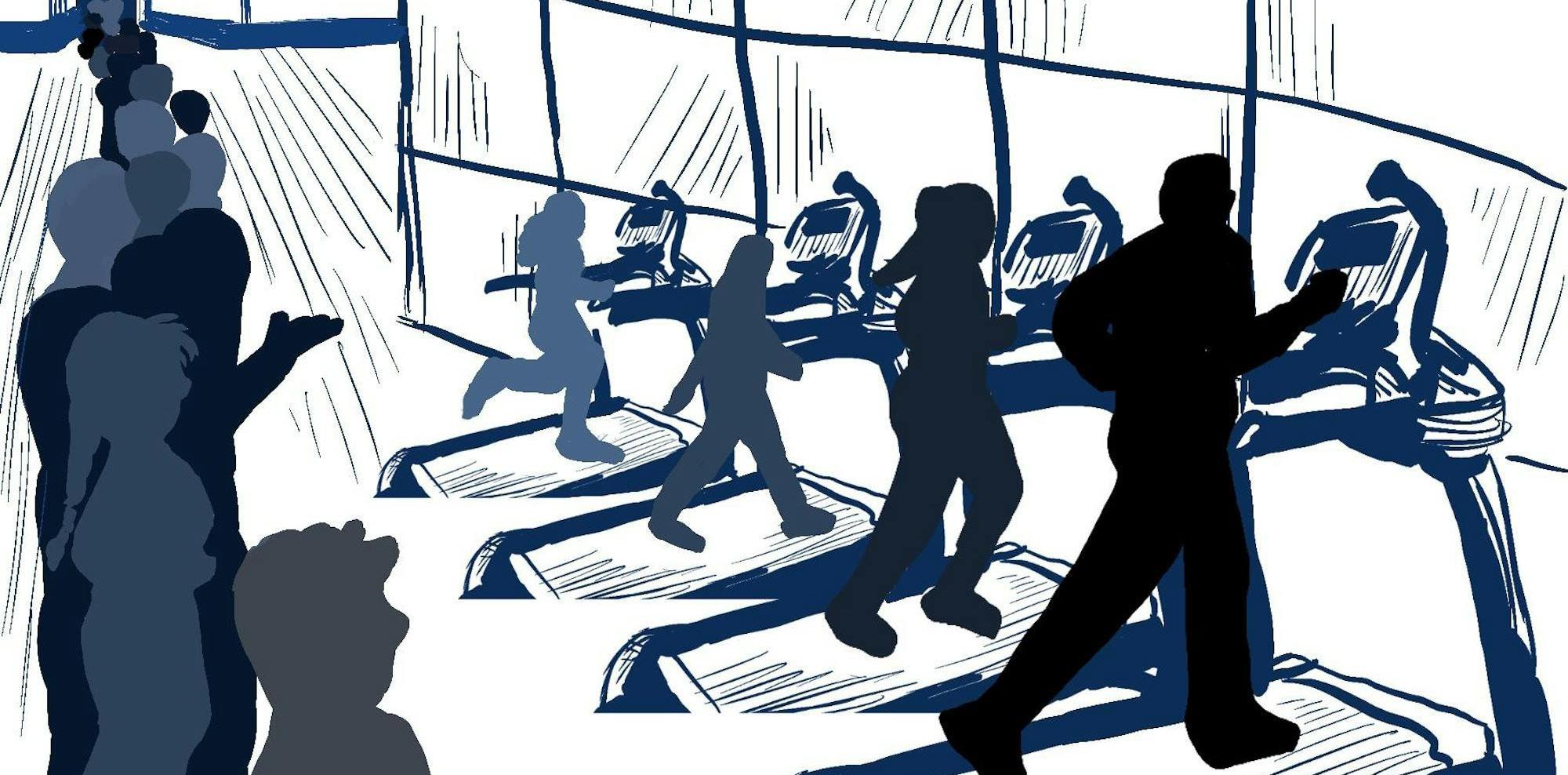
knowledged benefits of regular physical activity, Tufts is in danger of turning its students away from a healthy lifestyle with a congested gym. First, Tufts should expand gym hours. Currently, the Tisch Fitness Center is open every weekday from 7 a.m. until 10:30 p.m. However, other universities in Boston such as Harvard, MIT and Boston University all have gym hours that regularly last from 6 a.m. until 11 p.m., with Northeastern and Boston College’s gyms typically remaining open even longer. Increasing gym hours would put Tufts on par with other Boston universities and work to reduce congestion by spacing out students’ workout times over a longer period.
In addition to expanding regular gym hours, Tufts should also consider offering alternate gym spaces. Of course, Tufts should ultimately look to begin building a new gym that is able to meet student demand.
In the short term though, Tufts can add gym spaces to existing or forthcoming spaces that supplement
the Oscar-winning documentary “20 Days in Mariupol.” The film reveals a unique first-person perspective of the siege of a Ukrainian port city of almost 500,000 residents by the Russian army in the spring of 2022. Director Mstyslav Chernov, photographer Evgeniy Maloletka and producer Vasilisa Stepanenko were the last remaining journalists who stayed in the area during the initial stages of the full-scale invasion and were thus able to capture the war crimes committed by the Russians in Ukraine.
During the post-screening discussion facilitated by Professor Oxana Shevel, director of the International Relations Program at Tufts, attendees talked about Mariupol as one of numerous examples of Russia’s violence in Ukraine, though many other cases remain undocumented due to the limitations imposed by the mili-
the main center. For example, Tufts could add a few machines, weights and stretching areas to underutilized dorm spaces that could be accessed all hours of the day with an ID card. Additionally, Tufts should look to build these gym spaces into ongoing dorm projects, such as the planned new residence hall on Boston Avenue and the Blakeley Hall renovations.
Tufts is fundraising for a new aquatics center. The new facility, once funded and constructed, would provide Tufts with an opportunity to add more space for personal exercise, club use and physical education class space, alleviating the current strain on the Tufts gym. The site of the Hamilton pool could then be utilized for a variety of purposes, but the university could especially consider expanding the weight room or adding a rock climbing gym. Currently, the large Tufts Climbing Team has to go off campus to practice, and members have to pay a steep cost of $95 per month for a climbing gym membership. A
tary action and temporary occupation. Even in the case of Mariupol, we can only learn in relative detail about the early days of the siege. It lasted for 65 additional days after the AP journalists left. Survivors say that further into the full-scale war, the realities became increasingly terrifying.
Among other atrocities, Russian troops dropped a bomb on a theater where civilians were sheltering. At some point, most of the remaining population of Mariupol had no choice but to hide inside of a steel plant, called Azovstal Steel Works, as staying in the city left almost zero chances for survival. The journalists had already left by that time, in order to ensure that the footage would make it out to the international community — if they were captured by Russians, the materials would be destroyed and the reporters imprisoned or killed.
new rock climbing gym in the place of the Hamilton pool would provide students with a valuable and fun exercise opportunity and could allow the university to open up rock climbing PE courses. Not only should Tufts look to add new gym spaces, but they should also look to improve existing areas that could be better utilized for physical education. For example, Tufts should look to repair the drafty Jackson gym, where several club and varsity teams hold practices, and convert the old squash courts in the fitness center. Tufts has already transformed some of this space into a golf simulator for the golf team, and our recommendation is that they simply add another simulator that students may reserve. The university could also use another golf simulator for PE classes, which presently fill up extremely quickly.
The final piece to addressing increased physical fitness availability on campus should be to
In his acceptance speech for the Oscar for Best Documentary Feature, Chernov said, “I’ll be the first director on this stage who will say, ‘I wish I never made this film,’” expressing his anger and sadness at what he had witnessed. Still, we cannot underestimate the value of the movie. It is a crucial resource for understanding the lives of Ukrainians in frontline localities and a record of the cruel tactics Russia utilizes in their war against Ukraine.
When I saw “20 Days in Mariupol” when it premiered in Cambridge, I met filmmaker Mstyslav Chernov in person and heard from Ukrainians who have immediate family in Mariupol. I heard a woman whose parents still live in the city thank Chernov for showing the terrifying realities faced by locals and share her personal observation that places of such military action store the mem-
expand the offerings of PE classes by adding more instructors. To say that PE classes at Tufts fill up quickly is an understatement — the vast majority are completely filled by the time first-year students and sophomores register for classes. The university can open up more space for these classes by following our prior recommendations and can attain the goal of a better physical education program at Tufts simply by hiring more instructors to teach the courses. Moreover, Tufts could consider allowing students to earn credit by teaching PE courses; students already teach drop-in fitness classes for the Tufts University Social Collective. The university has already tested the peer teaching model with the Experimental College. It should be even easier to apply this model to PE classes since the grading is based mostly only on attendance and participation. In addition, typical PE instructors are not expected to have advanced degrees in order to be qualified to teach.
Tufts should recognize that its student body knows the many benefits physical fitness provides college students and seek to help foster the growing spirit of exercise on campus. Although some students might currently be dismayed at the crowded gym and disappointing lack of PE class availability, they should be assured that the problem is only temporary, as there are a plethora of solutions. Just like a beginning weightlifter, the Tufts administration may feel that they are wasting their time and could be pursuing academics instead; we hope that Tufts will soon find that investing in the gym is sure to work out.
ory of violence for a very long time, as one can almost “feel the death in the air.” Mstyslav agreed. It is vital to people who have lived through traumatizing events to have their story told and the injustices they experienced acknowledged. In addition, due to this record, perpetrators cannot fail to recognize their responsibility for the horrors depicted. I’ve watched “20 Days in Mariupol” four times, but seeing the destruction and death brought by the war never gets easier. Screening the documentary is essential for educating student bodies, including at Tufts, about the war in Ukraine — it should be shown by as many departments and communities as possible.
Mariia Kudina is a junior studying studio art. Mariia can be reached at mariia.kudina@ tufts.edu.
The Tufts Daily is a nonprofit, independent newspaper, published Monday through Friday during the academic year, and distributed free of charge to the Tufts community. The content of letters, advertisements, signed columns, cartoons and graphics does not necessarily reflect the opinion of The Tufts Daily editorial board.
EDITORIALS: Editorials represent the position of The Tufts Daily Editorial Board. Individual editorialists are not necessarily responsible for, or in agreement with, the policies and editorials of The Editorial Board. Editorials are submitted for review to The Tufts Daily Executive Board before publication.
VIEWPOINTS AND COLUMNS: Viewpoints and columns represent the opinions of individual Opinion editors, staff writers, contributing writers and columnists for the Daily’s Opinion section. Positions published in Viewpoints and columns are the opinions of the writers who penned them alone, and do not necessarily represent the opinions of the Daily itself. All material is subject to editorial discretion.
OP-EDS: Op-Eds provide an open forum for campus editorial commentary and are printed Monday through Thursday. The Daily welcomes submissions from all members of the Tufts community; the opinions expressed in the Op-Ed section do not necessarily represent the opinions of the Daily itself. Opinion articles on campus, national and international issues should be 600 to 1,200 words in length and submitted to opinion@tuftsdaily.com. The editors reserve the right to edit letters for clarity, space and length. All material is subject to editorial discretion and is not guaranteed to appear in the Daily. Authors must submit their telephone numbers and day-of availability for editing questions.
ADVERTISEMENTS: All advertising copy is subject to the approval of the editor in chief, executive board and business director.
OPINION 9 T HURSDAY, M ARCH 14, 2024 THE TUFTS DAILY OPINION
EDITORIAL
Editorial Board
GRAPHIC BY BEX POVILL
The overdiagnosis and overmedication of ADHD: Shortage or shortcut?
Gretta Goorno Opinion Editor
Originally published March 8.
When I was five years old, I would climb onto my family’s circular oak table and hoist myself into the air, miraculously dangling — and swinging — from the faux-crystal chandelier. My third grade teacher can thank me for her fashionable rubber band ‘bracelets.’ She tallied my “blurt-outs” on them, granting me a prize if I was under 10 by the end of the week.
Though I knew every statistic relating to professional hockey and binge-watched countless science documentaries with my grandpa, I could not and would not pay attention in class. I was aptly diagnosed with Attention Deficit Hyperactivity Disorder at eight-and-a-half years old, and I have been taking medicine ever since. Yet, until recently, my thoughts on ADHD had been contained to my own personal experiences.
In October of 2022, the FDA officially announced a national shortage of Adderall, commonly used to treat ADHD. This July, they added additional stimulants, such as Vyvanse and Concerta, to the list in short supply. Although the name-brand Vyvanse and Concerta stimulants are reportedly in stock again, their generic versions remain in short supply. The shortage is due to high demand coupled with a supposed
inability to meet said demand. Currently, one of my stimulants is on backorder for 20 days at a time. Luckily, I have access to a nearby CVS and the ability to pay for my medication. But for many stimulant takers, uncertainty is abundant. In the past year, nearly 40% of caregivers and adults with ADHD said patients were struggling to obtain their ADHD medication. Some have stopped taking it altogether, while others have had to switch brands of medicine. In both cases, withdrawal and unforeseen side effects can follow. Additionally, price increases of already expensive drugs have left many families in financial disarray.
Adderall alone accounted for more than 41 million dispensed prescriptions in 2021. During the pandemic, it became even easier and more trendy to get an ADHD diagnosis. In 2020, the U.S. Department of Health and Services suspended the 2008 Ryan Haight Act, newly allowing patients seen solely over telehealth to receive a prescription. As a result, many organizations, including remote startups, began to diagnose and prescribe ADHD medicine after mere half hour online chats. Stephen Hinshaw, an ADHD expert who teaches psychology at the University of California, Berkeley, credits the increase in diagnoses to the “TikTok phenomenon.” On various social media platforms, content creators pushed “quick and dirty” online self-diagnosis questionnaires. Telemedicine startups flooded these
same platforms, advertising stimulants for people who felt distracted. Though a label of ADHD can help individuals feel validated and receive adequate services, it should not be thrown around casually.
A large portion of my immediate and extended family has ADHD. While I have seen firsthand the benefits of medication and costs of going without, I remain skeptical of the overdiagnosis and overmedication of ADHD. My medicine has helped me tremendously, yet at the same time, I wonder where I would have been without it. Perhaps I would have found a way to cope naturally, or perhaps I would have gone off the grid to become a starving artist. Either way, I sometimes feel like I should’ve given life without stimulants a shot.
While the onus to resolve this crisis falls on manufacturers and the Drug Enforcement Administration, to stop pointing fingers at one another and start working together, we all have a responsibility to re-examine our relationship with ADHD to help resolve the shortage and create healthier lives. The sentiment that “everyone has a little ADHD” is widespread, yet many believe that children who struggle to sit still should be prescribed countless pills. The contrast between these viewpoints has led me to feel strange about my own ADHD. ADHD is a very real part of me that I am proud of. I believe it is partially to credit for my
30-page deep-dive papers for assignments that were only supposed to be five pages. It has also inspired both my creative side and my clumsy, goofy side that I adore. Yet, it is really hard for me to get work done without, and even with, my medication. When people who do not have the condition trivialize it by blaming ADHD for their fidgeting or saying that ADHD is just a “College Board hack,” I become frustrated. As a child, despite having a high IQ, I often performed subpar in school. To this day, I struggle with issues of time management and distraction.
As of 2019, 62% of two to 17-year-olds diagnosed with ADHD took medication for ADHD. In the hustle-oriented society we live in, it is important to be productive. Flunking school and having impulsive tantrums is undeniably less than desirable. However, there simply shouldn’t be any toddlers or preschoolers diagnosed, let alone medicated, for ADHD. Even in older children, medicine should be prescribed only after behavioral and natural treatments such as exercise and time outdoors have been tried. As a child, my medicine stunted my crazy, goofy energy. Certain medications have increased my anxiety, making my mind run even faster than normal. Sometimes, I find myself extremely tired when I do not take my afternoon medicine. Before seeking a diagnosis or medication, it is imperative to understand the unique tradeoffs for everyone who lives with and takes medicine for ADHD.
The compromised ethics of the TCU Senate, Part 1
Kevin Golub Opinion Editor
Originally published March 12.
On March 3, I watched in horror as students packed into the Joyce Cummings Center ballrooms to support the vehemently antisemitic resolutions proposed by the Coalition for Palestinian Liberation at Tufts before the Tufts Community Union Senate. Several of the resolutions were directly inspired by the boycott, divestment and sanctions movement. The resolutions called on Tufts to “divest from Israeli Companies [and] to divest from companies invested in Israeli Apartheid and with ties to Israel” and “[urged] the Tufts Dining office to stop selling any Israeli products immediately and indefinitely.” BDS has been called antisemitic because it questions Israel’s right to exist and singles out Israel for its treatment of its Arab citizens, when minorities in some countries suffer far more. Furthermore, BDS has member groups including Hamas, the U.S-designated terrorist organization that slaughtered, kidnapped and reportedly raped numerous women and children on Oct. 7.
In the nearly five-hour Senate meeting, students backing CPLT frequently interrupted those opposing the resolutions. The Senate didn’t effectively enforce appropriate behavior and conduct when the meeting began. Only after Jewish speakers were interrupted repeatedly did they remind students to abide by the Senate’s guidelines.
The meeting got off to a poor start: TCU Senate read an unpublicized version of the first resolution without informing the opposition. The first resolution, antisemitic due to its strong link to BDS, asked for Tufts to end all approval for external study abroad programs in Israel. Although it was later corrected, not only did this mistake demonstrate the Senate’s lack of preparation, but it also forced Jewish students to listen to the antisemitic resolution again. This mistake set the stage for continued instances of the Senate’s unprofessional handling of the meeting.
Throughout, I was stunned by how much time was spent debating simple gram-
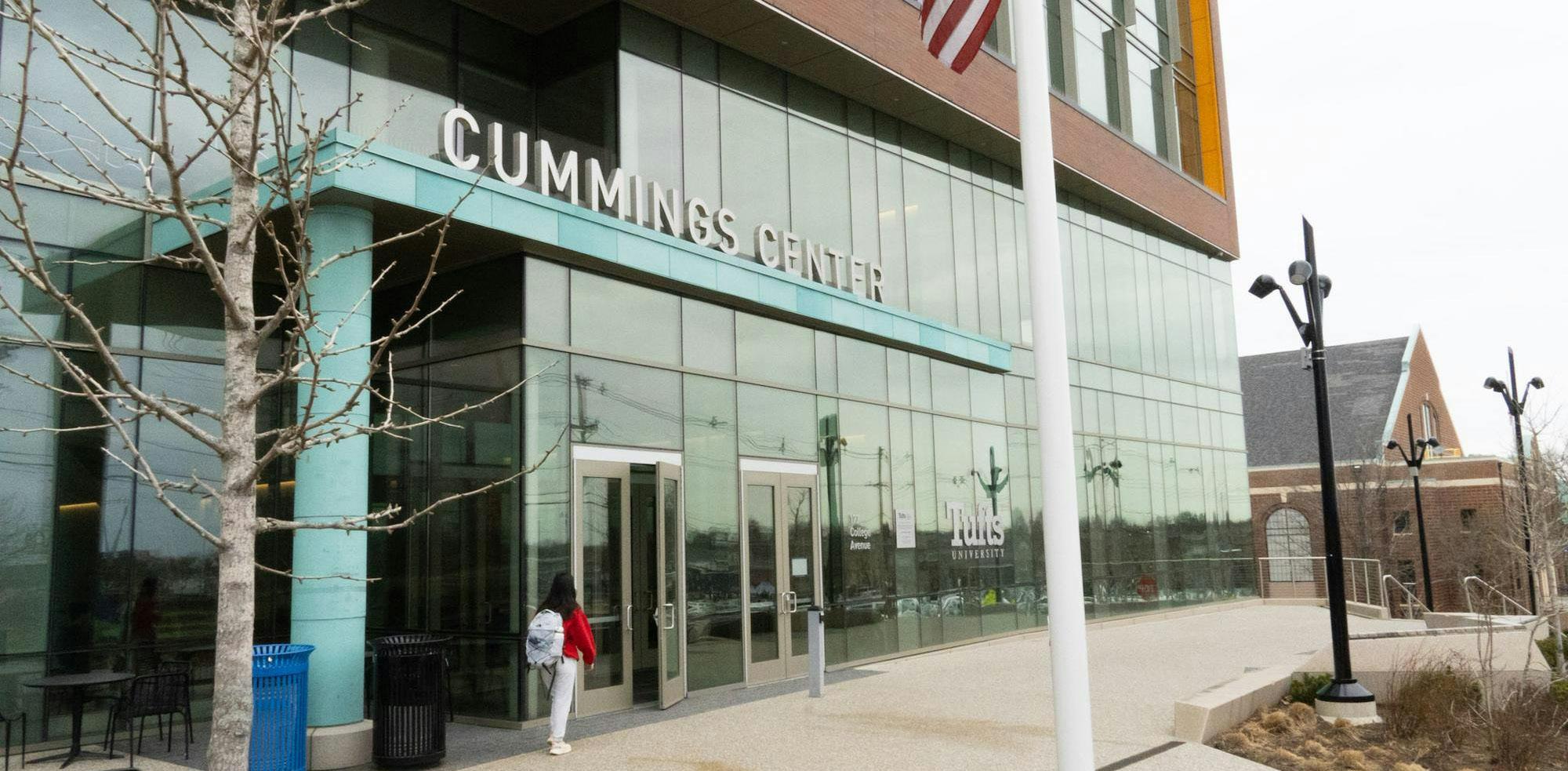
matical changes. The “Non-Substantive Amendments” portion of each resolution did little but prolong the tense and emotional hearing. TCU Senators’ time would be better spent encouraging ethical, diplomatic and appropriate behavior instead of inspecting Oxford comma usage, especially in meetings with such important implications for so many students.
TCU Senate’s mishandling of the proceedings also included failing to direct authors of resolutions to answer questions thoroughly. Numerous inquiries into the resolutions’ statements, reasonings and language were sidestepped and not addressed. Supporters of the resolutions were able to circumvent many questions about the horrific events of Oct. 7, reasoning that Hamas’ attack on Israel was not explicitly mentioned in their resolutions and thus was not relevant to the hearing. They also didn’t directly clarify which part of Israel they believe is occupied. This is ridiculous, seeing as comments made by Students for Justice in Palestine, a CPLT member organization, following Oct. 7 doubtlessly prompted University President
Sunil Kumar’s response. Additionally, the Hamas attack on Oct. 7 directly instigated the current war with which supporters of the resolutions have taken issue, demonstrating the relevance of these questions. Supporters shouldn’t be able to pick and choose events that best fit their agenda. The Senate’s draconian policies surrounding the scope of questions prevented objecting students from rightfully condemning the heinous acts committed by Hamas on Oct. 7. As a mediator for debate, the Senate should have intervened to ensure that the group putting forth and defending the resolutions accurately and appropriately answered relevant questions.
It appeared that each speaker arguing against the resolutions spoke respectfully and considerately. Conversely, the resolutions’ supporters, directing their attention towards the opposition, were consistently rude and dismissive toward Jewish students. The Senate refrained from interfering when arguments for the resolutions turned into personal attacks outside the debate’s time. For example, I witnessed Jewish students in the opposition being called “racist” and
“antisemitic,” fabricated lies that the TCU Senate condoned.
Other double standards were visible in plain sight: One student in the opposition spoke about how it felt to be Jewish at Tufts since Oct. 7, given SJP’s actions. The Senate implied this was irrelevant. When someone in support of the resolutions accused the opposition of using “Jim Crow filibuster tactics,” that was deemed relevant. Mere minutes after this accusation, they used time allocated for opposition speakers to amend the resolution, cutting into debate time in the same fashion that they had called “Jim Crow.” When a Jewish speaker expressed sympathy for what a Palestinian student was going through, he was relentlessly booed and told later in the evening by the Senate to bring the conversation back on topic. Finally, Senate moderators failed to cut off numerous speakers once they had spoken for one minute, which I noticed overwhelmingly occurred for pro-resolution speakers. This is yet another example of how the Senate neglected to enforce the rules during a hearing of such great importance.
OPINION 10 T HURSDAY, M ARCH 14, 2024 THE TUFTS DAILY VIEWPOINT
VIEWPOINT
PHOTO BY ARI NAVETTA / THE TUFTS DAILY
The Joyce Cummings Center is pictured on March 2.
Memorable men’s basketball NCAA run comes to a close
energy and fan support, fueling momentum and allowing for offensive runs.
“They had a huge crowd, obviously, being a Sweet 16 game,” Gyimesi said. “That was just a huge factor in and of itself. Any play that went even remotely in their way, the energy just (cut sort of) shifted to them. As an away team or visiting team, like we were, you have to sort of balance that.”
Unlike the previous two matchups, the Jumbos defended the basket and outside key better, allowing for fewer total points scored and forcing more difficult 3-point shots. Entering the half, Tufts held Trinity to just 25 points. The Jumbos tallied 21 of their own, thanks to a late 3-point make by junior guard Khai Champion to cut the lead to four. Heading into the second half, the Jumbos capitalized on their momentum, coming out strong and trading leads and tied scores with the Bantams for the first 10 minutes. The Bantams played to their
strengths, however, and got hot beyond the arc, steadily piling on a lead. After his momentum-shifting 3-pointer in the first half, Champion acknowledged a similar play by the Bantams in the second half.
“They went on a little run in the second half and we had a good possession of defense,” Champion said. “Basically, played good defense for most of the shot clock, and at the end of the clock — I forget who it was on their team — one of their bench guys had a three off the backboard that went in, and then the crowd just went absolutely ballistic. And that continued their run.”
Despite not getting the desired outcome, the Jumbos finish with an impressive NCAA run. Champion described the late-season practices and the teamwide work ethic.
“This year, our run in the NCAAs were some of the best, most focused, most intense practices that we’ve had,” Champion said. “I think taking that focus and intensity and just being able
to experience that was really valuable for me because it showed the potential we have to really lock into a game plan, and really work hard and practice and challenge each other to face really hard opponents.”
Bernstein provided another lesson learned from the season and expanded on the valuable experience for the young roster moving forward.
“I was watching the Trinity postgame press conference, and they were talking a little bit about how their shift from last year to this year is discipline,” Bernstein said. “That’s exactly where we’re at right now. We’re making that shift to just a completely different team when it comes to our mental state. … So I think more than anything, as opposed to just getting in the gym and getting shots up, that’s all going to come, it’s more of a mentality shift where we just have to understand truly what it takes. We got a little bit of a taste this year, and so we now know what it looks like. But, obviously, we’re always gonna want more.”
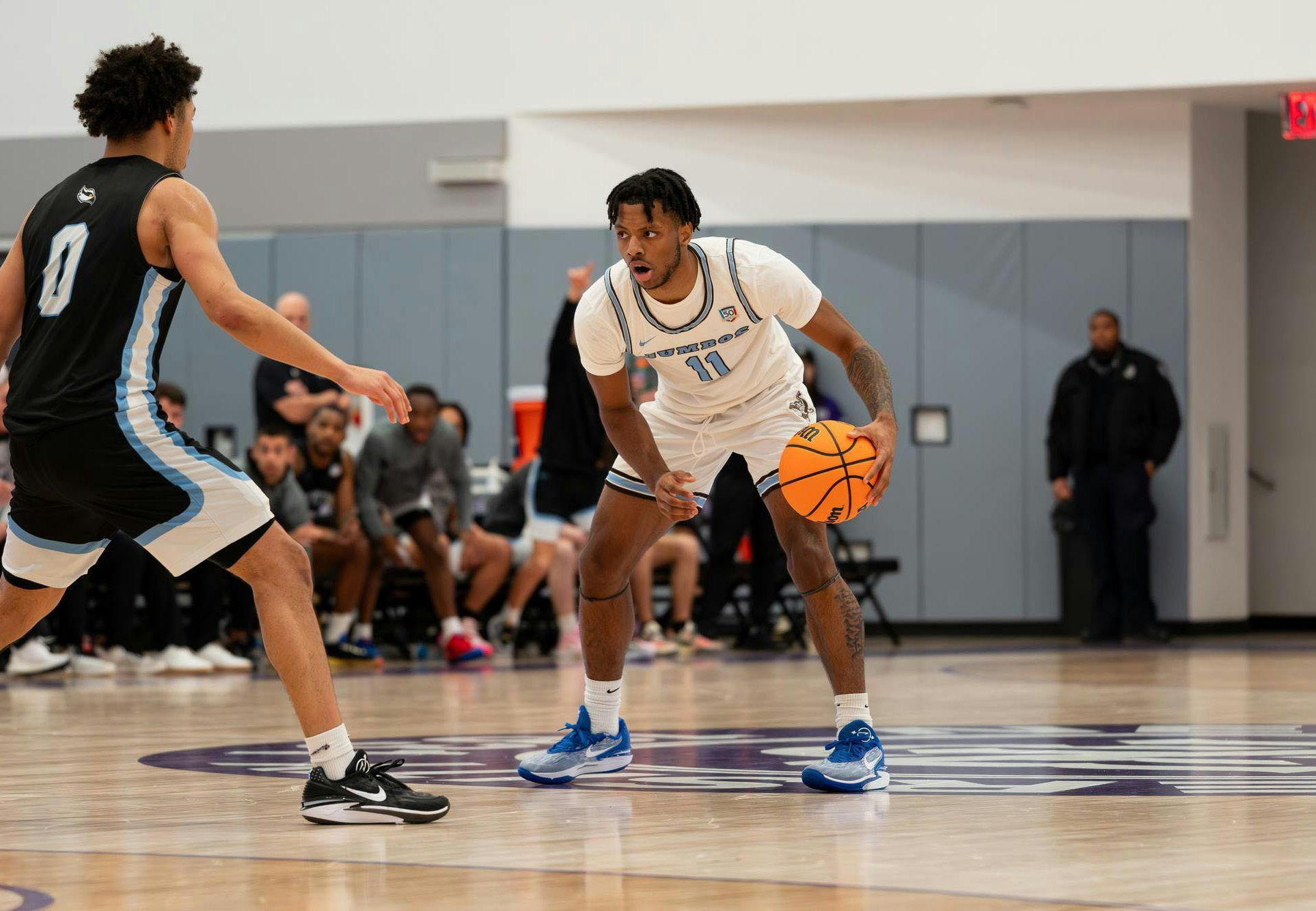
Women’s lacrosse continues undefeated season
LACROSSE
continued from page 12
as well as Lesperance and sophomore attacker Allie Zorn, who scored three goals each.
“I think our attack this year really has a lot of threats, [so] then, when you get in that type of situation, when we are given possession from the draw team, we can make some good things happen,” Carden said.
The Jumbos’ defense was also essential in keeping the Bantams’ scoring to a minimum. The defense caused eight turnovers and junior goalie Pascale de Buren had seven saves.
Zorn explained that the depth of talent on Tufts lacrosse contributed to their success against Trinity.
“This year, especially, we’re rotating more attackers, we’re playing that second middie line [and] we have defenders coming in and out,” Zorn said. “Being able to show the other teams different matchups and different offensive skill sets [makes] it hard for the other team to get into a rhythm of defending us and trying to stop us because they
have to adapt to what we’re showing them. If that’s constantly changing, it’s pretty hard to keep up.”
On Wednesday night, Tufts continued its undefeated streak, winning against No. 23 SUNY Cortland at home 19–4. Tufts will play Hamilton on Saturday in Clinton, N.Y.
The Jumbos are hoping to build on these early season successes in anticipation of the postseason. Last season, Tufts fell in the quarterfinals of the NCAA Tournament, and hope to go farther this season, which has led to a renewed energy to start the season.
“Last season we definitely were disappointed with our result. We thought we could have gone a lot further than that and had a pretty unfortunate ending,” Delaney said. “[That ending] just didn’t really feel right to us, so going into this fall, we definitely focused more on being prepared coming into preseason. I think our entire team bought into that whole mentality because they felt the disappointment of last season, and everyone knows how capable we are of taking it so much further than that.”
Henry Blickenstaff
Extra Innings
Top 10 players for 2024
Honorable Mentions:
Austin Riley, 3B, Atlanta Braves; Francisco Lindor, SS, New York Mets; Julio Rodríguez, CF,, Seattle Mariners
10. Matt Olson, 1B, Atlanta Braves
Olson has been one of the game’s best sluggers for the past several seasons. Since 2021, he has 127 homers and 353 RBIs with a .902 OPS, and he’s missed only six games in that span. Last season, he led all of MLB with 54 homers and 139 RBIs and posted an NL-best .604 slugging percentage.
9. Marcus Semien, 2B, Texas Rangers
Last year, Semien finished in the 99th percentile for outs above average while racking up 29 homers, 40 doubles and an .826 OPS — outstanding offensive numbers for a second baseman. He’s also missed just eight games in the last five seasons combined and has accumulated 29.1 WAR in that span.
8. Gerrit Cole, P, New York Yankees
Cole was a bright spot on a Yankee team that was otherwise a bitter disappointment last year, winning his first career Cy Young award. Over his last six seasons, he has a 2.93 ERA and 0.991 WHIP, and he’s struck out 1,418 batters in 1,076 and two-thirds innings.
7. Aaron Judge, RF, New York Yankees
Judge didn’t replicate his historic 2022 campaign, but he still posted a monstrous 1.019 OPS and hit 37 homers in just 458 plate appearances. The biggest concern for him is injuries — he played only 106 games last year, and he’s missed substantial time in previous seasons.
6. Corey Seager, SS, Texas Rangers
Seager is coming off the best year of his career, slugging .623, hitting 33 homers and posting 6.9 WAR despite playing just 119 games. He certainly looked to be worth every penny of the mammoth 10-year, $325 million contract he signed with Texas.
5. Juan Soto, LF, New York Yankees
Soto’s unreal plate discipline at such a young age gives him the potential to be one of the greatest hitters of all time. His 157 career adjusted OPS trails only Mike Trout and Judge among active players with at least 3,000 plate appearances, and he has yet to finish a season with an on-base percentage under .388.
4. Freddie Freeman, 1B, Los Angeles Dodgers
After barely missing the cut for my top ten last year, Freeman shut me up by putting together one of the best offensive seasons of his outstanding career, hitting .331 with a .976 OPS. He also set a Dodgers record for most doubles in a single season with 59.
The strong start has given Tufts confidence in their team and abilities to go far in the postseason, Gibbons explained.
“This season has definitely been one of pure excitement … [and] every single person is completely dialed into what this team is all about, which is winning a national championship,” Gibbons said. “There has been so much intention around being the best teammates, being the best team all together as a unit, and that has led to success so far.”
Though Tufts hasn’t had a challenging start to the season, they know that with their training and impressive skill set to fall back on, the Jumbos will be able to face bigger challenges throughout the season.
“I think everyone’s in a really good mindset right now, and [we’re] really excited to continue the season with how we’re looking,” Joyce said. “It’s not always going to be this smooth, but trusting that, ultimately, we love and support each other is going to help us in whatever tough situations we find ourselves in.”
3. Shohei Ohtani, DH, Los Angeles Dodgers
It might be a hot take having Ohtani this low, but since he won’t pitch at all this year, I’m evaluating him solely on his merits as a position player — which are still substantial. He’s coming off his best offensive season with a 1.066 OPS and 44 homers, both of which are otherworldly.
2. Mookie Betts, RF, Los Angeles Dodgers
Betts had the second-best offensive season of his illustrious career, hitting a .987 OPS with 39 homers, and led the National League in WAR with 8.3. At 31, Betts is already a top-50 player of all time in my book, and he’s showing no signs of slowing down.
1. Ronald Acuña Jr., RF, Atlanta Braves
Acuña is coming off only the fifth season in MLB history with 40 homers and 40 stolen bases, posting 41 and 73, respectively. The previous record for stolen bases in a 40–40 season was Álex Rodríguez with 46. He’s reached his full potential as the most ungodly combination of power and speed since a young Barry Bonds, and he’s still just 26.
Henry Blickenstaff is a junior studying history. He can be reached at henry.blickenstaff@tufts.edu.
SPORTS 11 T HURSDAY, M ARCH 14, 2024 THE TUFTS DAILY
COURTESY TUFTS ATHLETICS
First-year guard Jon Medley is pictured in the March 1 game against Stockton.
BASKETBALL
continued from page 12
Zachary Gerson
In the Crease
Hart Memorial Trophy predictions
This week’s focus is on the Hart Memorial Trophy, which is awarded to the league’s most valuable player. The MVP is the player who is determined to be the most important to their team’s success through outstanding on-ice performance.
Hart Memorial Trophy Winner: Nathan MacKinnon, Colorado Avalanche
The Avalanche center has put up an extremely impressive case for Most Valuable Player, and in doing so he should be the favorite for the award. He currently leads all skaters with 113 points, demonstrating his elite all-around play and domination. This point total consists of 41 goals and 72 assists, which shows how he is making both scoring and making plays. He also has a +28 plus-minus rating, meaning he has been on the ice for 28 more even-strength goals scored than even-strength goals scored against. As he always has, MacKinnon continues to dominate on the powerplay as well. He has been so dominant in all facets of the game this season that he is currently in third place for the longest home-point streak of all time. Without MacKinnon, the Avalanche would likely not be the top tier, elite team that they have been throughout the season, and that combined with MacKinnon’s spectacular performance is why he’s the front-runner for this season’s Hart Memorial trophy.
Hart Memorial Trophy Runner-Up:
Auston Matthews, Toronto Maple Leafs Matthews has continued his simply unbelievable scoring ways this season. He overwhelmingly leads the NHL in goals scored with 54. He is on pace for a hair under 70 goals for the entirety of the regular season, which is an incredible number of goals to score in a single season. Matthews has multiple hat tricks this season, which in many instances is the sole reason the Leafs won its game on that given night. He is arguably just as valuable to his team as MacKinnon is to his team. However, the reason why MacKinnon has the edge is that while they both have high goals scored, MacKinnon’s 71 assists blow Matthews’ 26 assists out of the water. Matthews has been incredible, but MacKinnon has been the ultimate allaround team player. This takes nothing away, though, from Matthews’ incredible performance and his deserving case to be in the conversation for the Hart Memorial Trophy.
Hart Memorial Trophy Third Place: Nikita Kucherov, Tampa Bay Lightning Kucherov has had an elite season that has flown under the radar because of the performances of MacKinnon and Matthews. Trailing only MacKinnon in points, Kucherov’s 107 are amongst the best in the league, and he has continually shown up game-in and game-out. Just like MacKinnon, Kucherov has been extremely well-rounded in his play, racking up 38 goals and 69 assists. It is really difficult to tell where the Lightning would be without his MVP-like performances. When others on his team may not have been performing at their best, he has been there to pick up the slack, which is precisely why he is in the Hart Memorial Trophy contention.
Zachary Gerson is a first-year who has yet to declare a major. He can be reached at zachary.gerson@tufts.edu.
SPORTS
Men’s basketball eliminated from NCAA Tournament by Trinity in Sweet 16
Keila McCabe Sports Editor
The men’s basketball team lost to the Trinity Bantams this past weekend in the Sweet 16, ending its incredible run in the NCAA Tournament. The Jumbos faced a tough obstacle in this year’s NESCAC champions, the Bantams. Tufts finishes its season 21–8 during the program’s fifth trip to the Sweet 16. After graduating four seniors who made big contributions on the court, the program looked to adjust, and went on to exceed expectations in its tremendous success. Sophomore forward Scott Gyimesi, one of three sophomores in a new starting role and the team’s season-high scorer, attributed this season’s smooth adjustment to senior leadership.
“From the outside it looked like this year would be a transition year for us, or a year of growth [with some] struggles because we’re a younger lineup,” Gyimesi said. “We lost five seniors, four
of which were major contributors to our team on the court last year. … There was just a lot of mystery going into this year, and [senior guard Jay Dieterle] and [senior guard Casey McClaren] … really just took that [leadership] role and ran with it.”
Tufts lost to Trinity twice before, once in the regular season, 82–66, and once again in the NESCAC tournament semifinal game, 80–68. The Bantams not only won the NESCAC but also added on accolades in winning this year’s NESCAC Defensive Player of the Year, earning two all-NESCAC first team slots and the award for NESCAC Coaching Staff of the Year. After the Bantams took down Tufts, they went on to win the Elite 8 matchup against Calvin University, now at an impressive 30–1 record. Tufts players described Trinity and technical factors that contribute to their success.
“There [are] a couple of systematic things that they do that’s tough to guard,” sophomore center Joshua Bernstein
said. “[Trinity] is a team that forces us to cross-match against them. So their big guy is not guarded by our big guy and vice versa. And they’re a very high 3-point shooting team. So in transition when you’re trying to find your guys, they aren’t next to you. When you’re on offense, you’re trying to get back to defense and you’re all mismatched, they can really take advantage of that.”
Gyimesi expanded on the team’s depth off the bench as an additional advantage.
“I think their second unit is incredibly strong as well,” Gyimesi said. “In their Elite 8 game, I think their second unit was plus 17 when they were on the floor, and they only won by 7. Their top guys didn’t really have a great night, but they were still able to advance to the Final Four.”
Additionally, playing at home, the Bantams benefitted from the home-court

No. 3 women’s lacrosse takes down Trinity 20–6
Tara Wirtschoreck Staff Writer
The Tufts women’s lacrosse team continued their undefeated season with a 20–6 victory over Trinity — who was No. 13 at the time — at home last Saturday. The win helped push Tufts up to a No. 3 ranking and a 5–0 record. With a strong showing across the field, the Jumbos proved that they’re a team to watch in the NESCAC and the NCAA this year.
Saturday’s game against Trinity was especially important because it celebrated “Scooter’s Game” to honor Madie Nicpon, nicknamed Scooter, a Tufts women’s lacrosse player who passed away in 2021. The Jumbos worked to celebrate her legacy and embody her energy during this game, senior midfielder Emma Joyce said.
“The focus was having fun, playing with her energy, being really positive throughout the entire game, and celebrating like she would. I think that was something that, ultimately, led to our blowout
victory,” Joyce said. “The energy was contagious all over the field.”
Many alums and Nicpon’s former teammates returned to celebrate her.
“I knew that it was going to be a little bit emotional at times, but [we] also had a lot of excitement and a lot of love on the field,” senior midfielder Madeline Delaney said. “Especially with all of our alums being back, [there were] a lot of people who played with Scooter and knew her. Having everyone back together was a really exciting thing for our entire team.”
Beyond the celebration of their former teammate, Tufts played an incredible game of lacrosse. Though Tufts started on the wrong foot, with two Trinity goals to start the game, they quickly got back on track. Junior midfielders Ella Lesperance and Caroline Conaghan both scored goals off of free positions to put Tufts on the board. After a third goal from Trinity, Tufts started their run, where the Jumbos scored 14 unanswered goals against the Bantams. The run was indicative of every unit of
the team working together and playing at their best.
Tufts started their dominance on the draw control, winning 21 of 28 draw controls. Junior midfielder Genna Gibbons and Delaney were instrumental in this, winning seven draw controls each. By gaining possession, the attack was able to push against the Trinity defense.
“Everyone just brought their A game, especially our attacking unit,” Gibbons said. “We were able to get them a lot of possession off the draw, and then they were totally executing every single play, picking apart Trinity’s defense, and really leaning into each other’s strengths and finding the back of the net often.”
The Tufts offense proved unstoppable for Trinity through the Jumbos’ 14-goal run. This high-scoring game saw contributions from many players, though, in terms of scoring. The Jumbos were led by junior attacker Margie Carden’s four goals,
SPORTS 12 T HURSDAY, M ARCH 14, 2024 THE TUFTS DAILY
see BASKETBALL, page 11
see LACROSSE, page 11 COURTESY TUFTS ATHLETICS
Ella Lesperance is pictured in the March 9 game against Trinity.






























